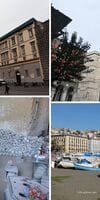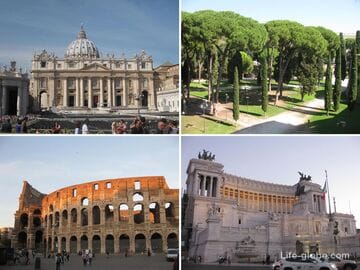The many faces of Naples, founded by Greek settlers in the 8th century BC, can cause mixed feelings.
The city is closely associated with the palaces, castles and villas of Naples, the kings and nobles, and well maintained majestic cathedrals stand side-by-side with small churches and dilapidated nondescript buildings.
This is, without doubt, a city of contrasts, where the narrow and dirty streets can bring to a well-tended bright green squares and parks, and the ancient part of Naples, hidden under layers of mineral resources, is not only one of the best examples of cities in which history can be traced through the "underground strata", but is also a separate group of sites.
Despite its versatility and, at first glance, a certain untidiness, Naples is impressive abundance and great diversity of attractions.
The Sights Of Naples. What to see and where to go in Naples
Plebiscito square (Piazza del Plebiscito)
The Piazza Plebiscito is the largest square of Naples, which used for holding large festivals, concerts, celebrations and other social events.
The square is decorated by two equestrian statues of Ferdinand I (the sculptor Antonio Cali) and Charles III (the sculptor Antonio Canova).

The perimeter of the area is concentrated monumental architectural objects:
Royal Palace (Palazzo Reale - Palazzo Reale di Napoli), the construction of which began in 1600 and lasted more than 50 years. Currently, the Palace is a Museum of the historical apartments of the Royal Palace;
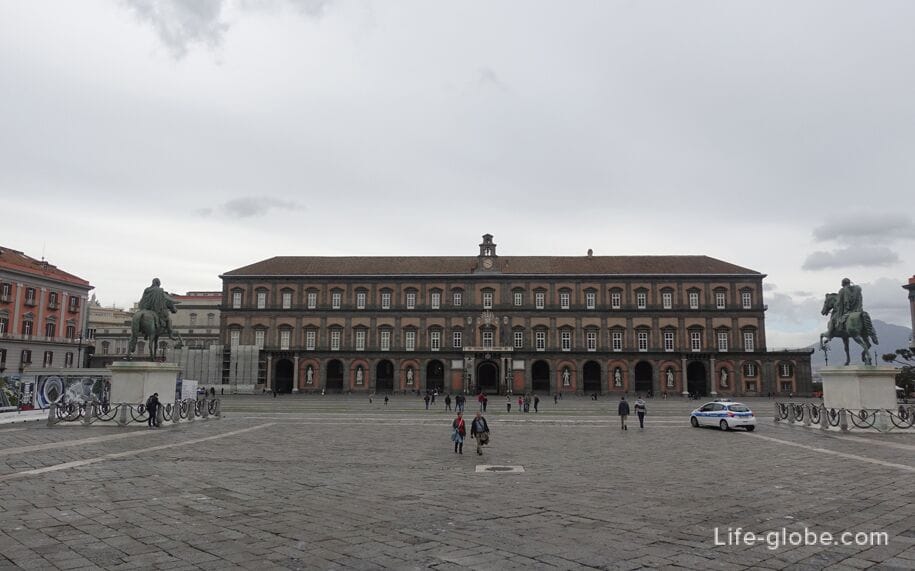
- the neoclassical Basilica of San Francesco di Paola (Pontificia Basilica Reale San Francesco da Paola), erected in the period between 1817-46 years and both sides with covered colonnades are semicircular;
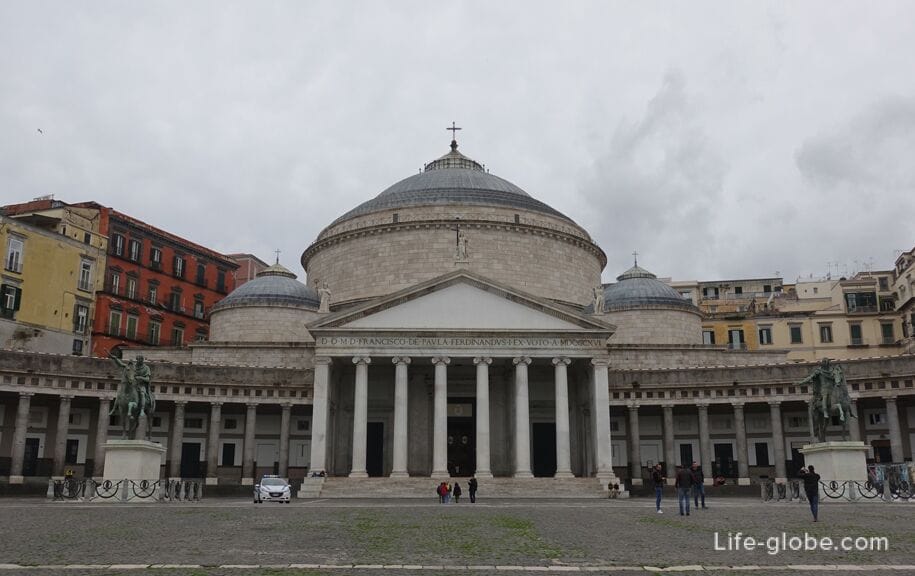
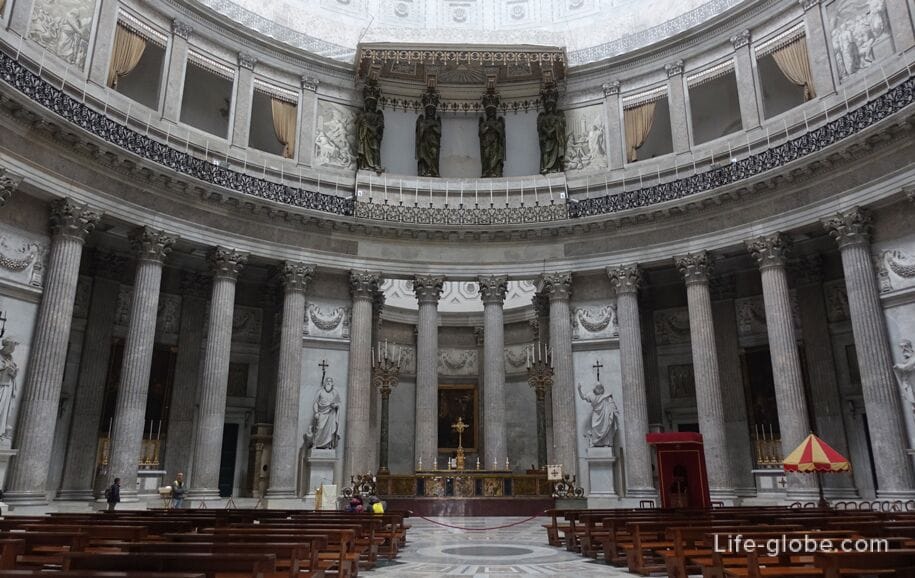
Palace of Salerno (Salerno, Palazzo) was built in the late 18th century and after several renovations;

Palace of the Prefecture (Palazzo della Prefettura), built in 1815 neoclassical architect Leopoldo Laperuta. Read more about Piazza Plebiscito in Naples...
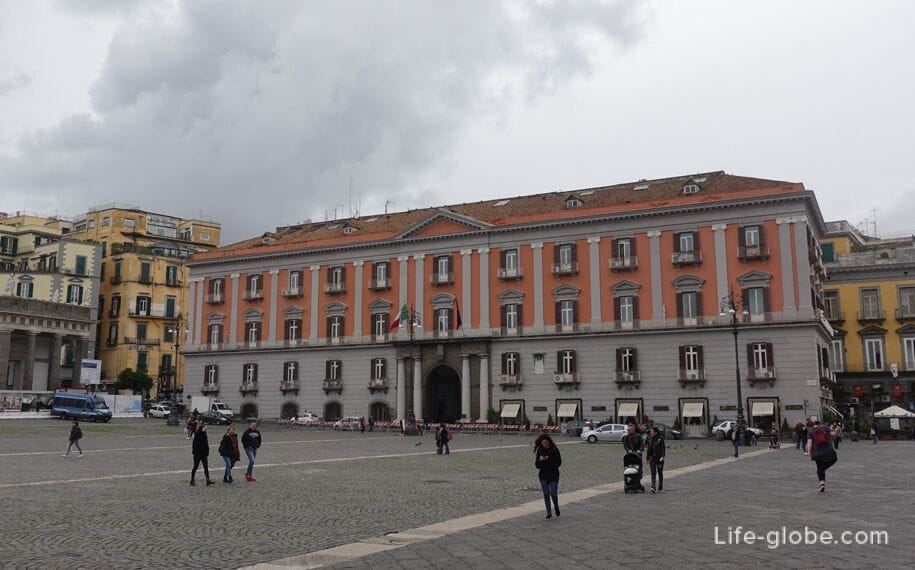
The Umberto Gallery (Galleria Umberto I)
Galleria Umberto I - the complex of historical shopping galleries of Naples, Neapolitan passage "bound" within its walls the shops and cafés.
The gallery was built between 1887 - 1891 years of the project Emanuele Rocco, who used modern architectural elements, and named in honor of the king of Italy Umberto I.
Galleria is a high and spacious cross-shaped structure topped by a glass dome. The internal space has four corridors (of the wing), along which shops, cafes and restaurants, tourist center, Museum and a few hotels, from which you can select 4-star resort hotel Art resort Galleria Umberto - style with spacious rooms. Read more about Galleria Umberto I in Naples...
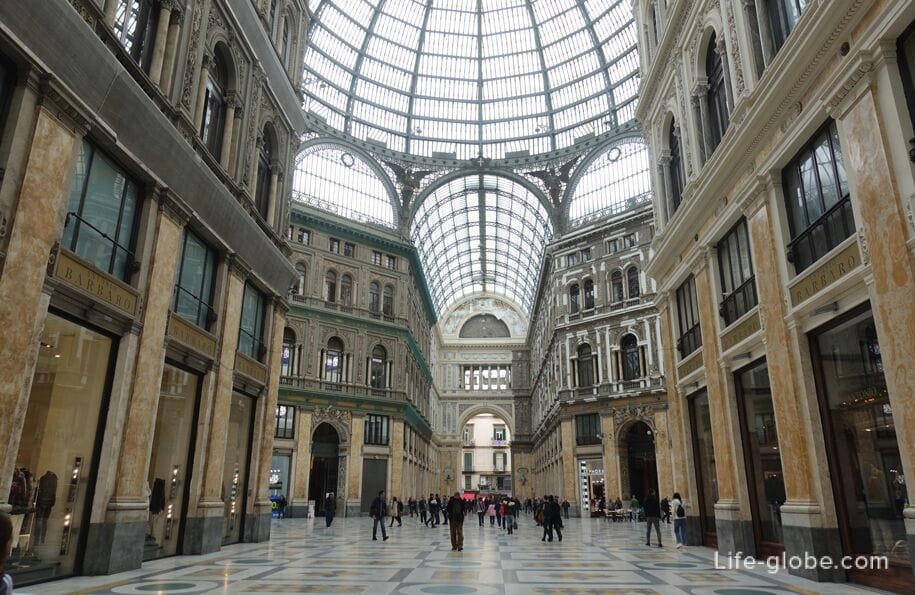
Teatro San Carlo (Teatro di San Carlo)
Teatro San Carlo is the oldest Opera theatres in Europe. Built on the orders of Charles III to replace the previously erected and already crumbling theatre "San Bartolomeo".
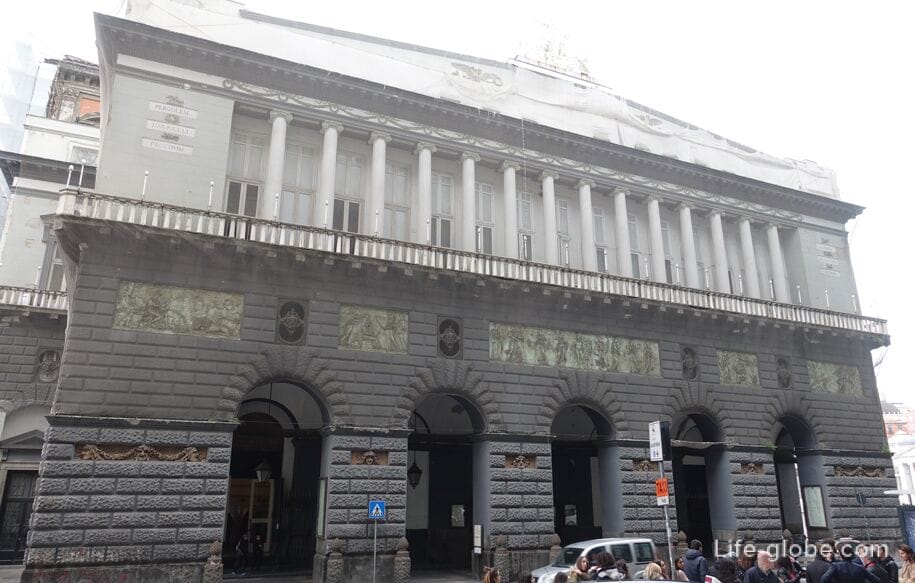
Area Trieste and Trento (Piazza Trieste E Trento)
Piazza Trieste and Trento has an irregular shape and is one of the most vivid squares of the historic center of Naples. The center of the square is decorated by a small fountain, Curcio or the Artichoke fountain (Fontana del Carciofo).
The square is the Baroque Church of San Ferdinando (Chiesa di San Ferdinando), built by the Jesuits in the early 17th century. Read more about Piazza Trieste and Trento in Naples...
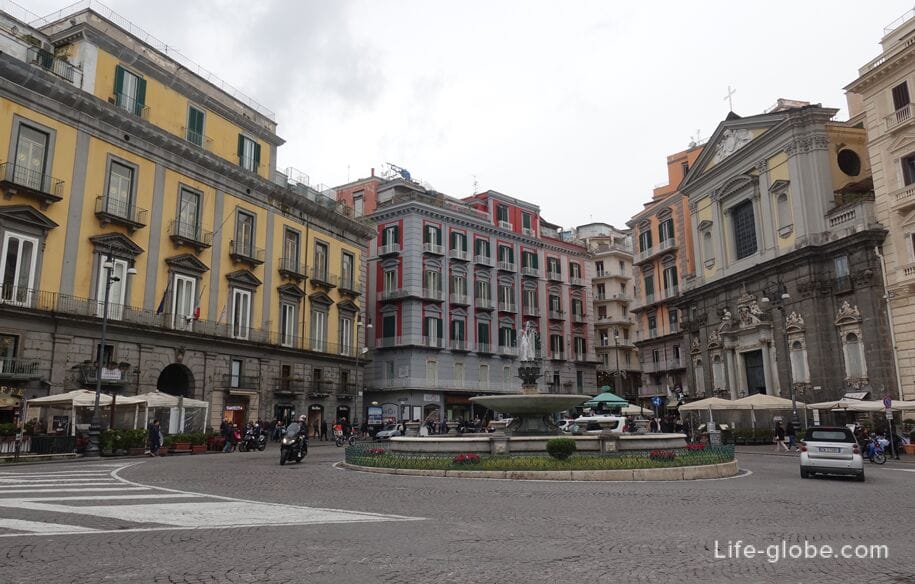
To Piazza Trieste and Trento are two of the most famous tourist street of Naples - Toledo and Chiaia, famous for their abundance of shops, cafes and restaurants and some interesting sights.
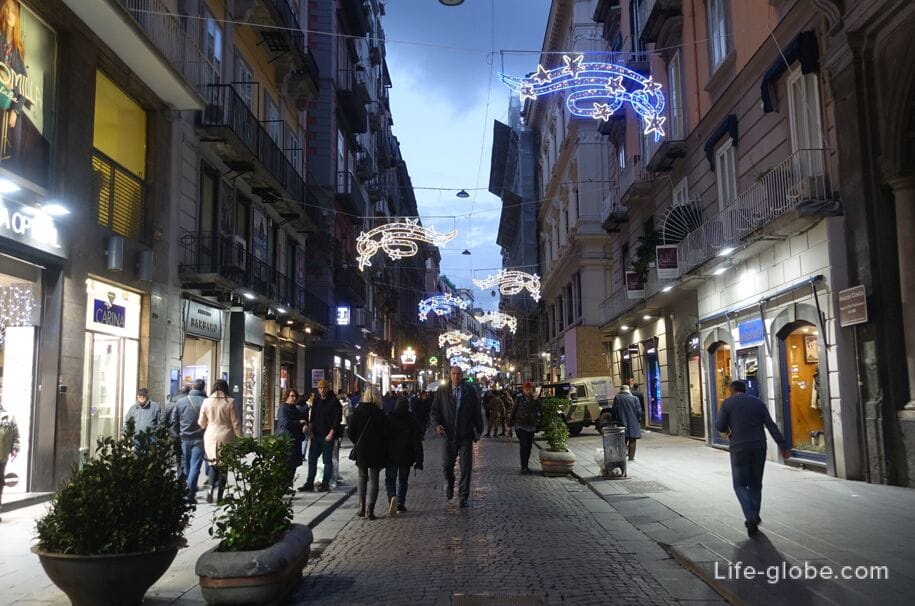

Pizzofalcone (Pizzofalcone)
Pizzofalcone - district, is a hill in Naples, main sights which are:
mountain Ecia (Monte Echia / Monte Echia);
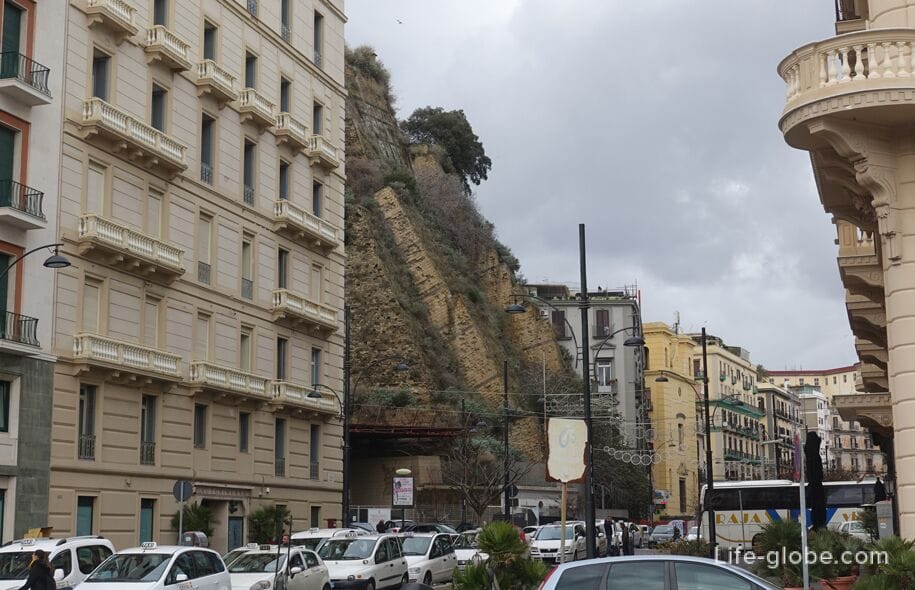
- eponymous Rampa Pizzofalcone street - Crookedest street of Naples;

- the remnants of the neo-Gothic Villa ebe (Ebe Villa), built in 1922;
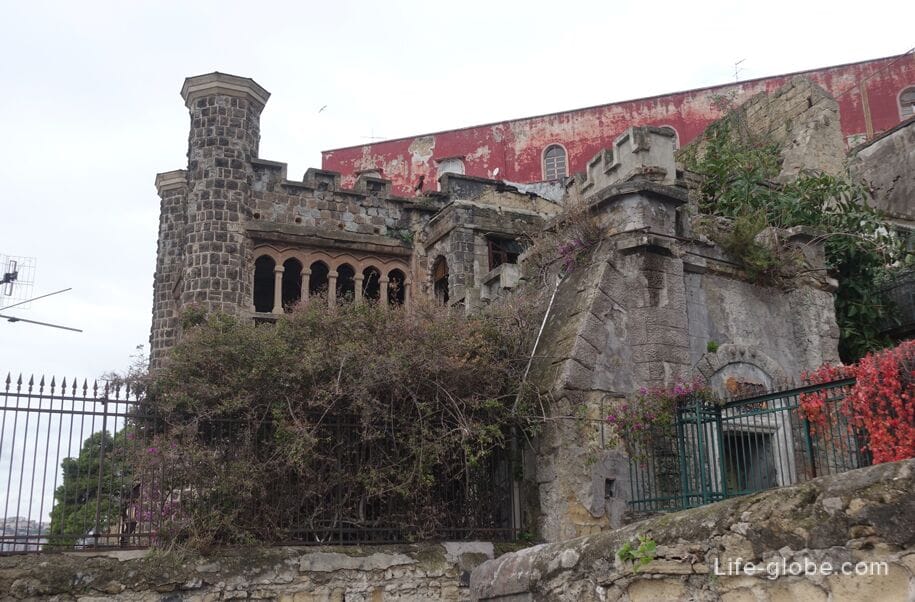
- some remains of a Roman Villa of Lucius, Licinius Lucullus, built in the first century BC.
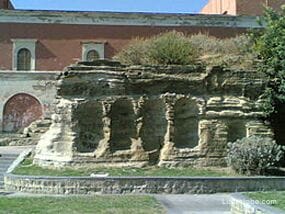
- small deck with panoramic views of old town Naples, the Bay of Naples and the surrounding area;
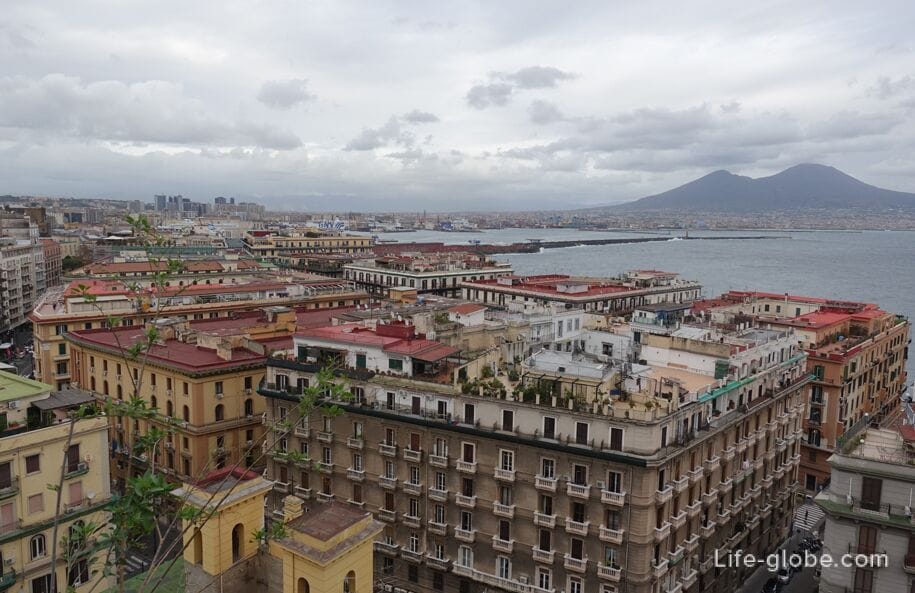
- barracks Nino Bixio. Previously, the Palace of Carafa di Santa Severina, built in 1512. Since 1808, the building housed the library and the Military Topographical office of the Kingdom of the two Sicilies. After the Unification of Italy, the building became a military archive and currently, its walls are the military section of the State archive of Naples and the police.
Since the late nineteenth century the entrance to the barracks was moved to the top of the hill, the street Monte di dio (Via Monte di Dio). Read more about Pizzofalcone...
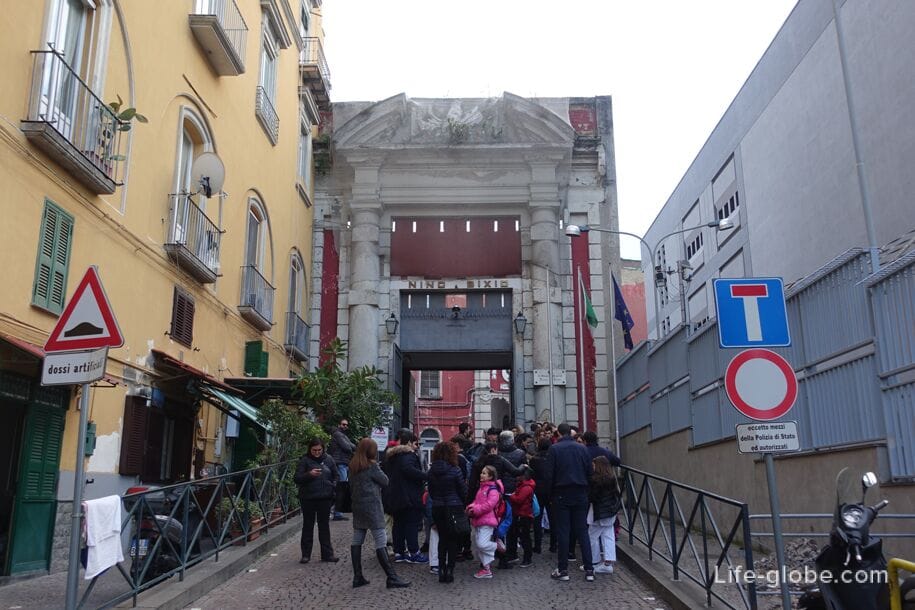
Castel Dell'ovo (Castel Dell'ovo)
Castel Dell'ovo or "Egg castle" / "the Castle of the egg," the oldest fortification built on a tiny island Megaride where the city was founded by colonists semeiskie.
The current appearance of the castle dates back to the Aragonese domination (15th century). During the Italian war, the castle suffered greatly from the French and Spanish troops. After a long period dilapidated, the castle acquired its present form during an extensive renovation, which began in 1975.
In the castle there are several terraces at different levels and a balcony with scenic views of the waterfront, the Bay of Naples and some of the surrounding area. Read more about the Castel Dell'ovo in Naples...


The Maschio Angioino (Castel Nuovo)
Castel Nuovo also known as Maschio Angioino castle in the translation literally means "New castle" historical medieval and Renaissance castle.
The construction of the ancient core, today partially revived after the restoration and archaeological research has occurred at the initiative of Charles I Anguissola.
At present the castle exhibitions and cultural events and also houses the Civic Museum.
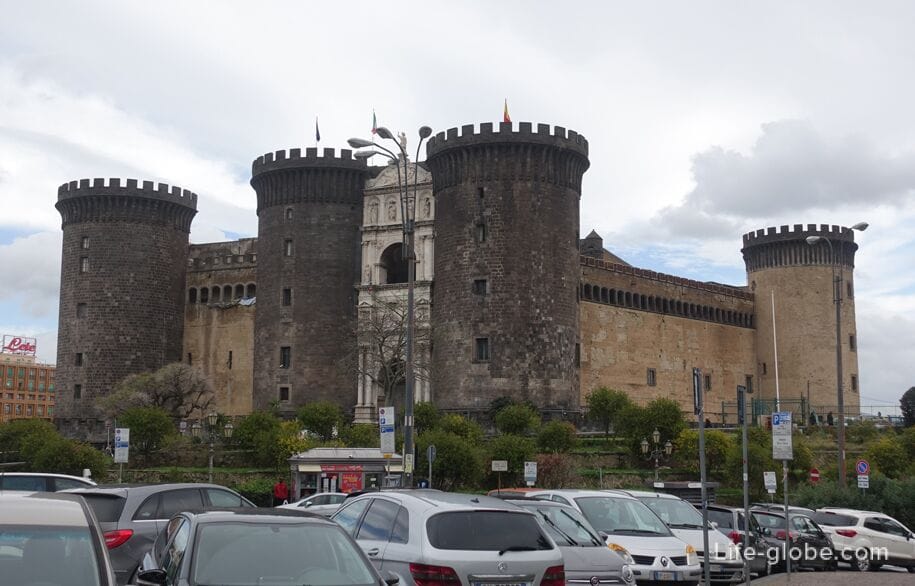
Castle Sant'elmo (Castel Sant'elmo) and the monastery of San Martino (Certosa di San Martino)
A medieval fortress located on the Vomero hill and erected in 1329, in the form of a hexagonal star.
Currently the fortress is a historical monument - the monumental complex of Castel Sant'elmo open to the public and all interested persons. It serves as a Museum, exhibition hall and offices.
Special attention deserves the top platform of the castle - Piazza d Armi (Piazza d'armi), facing the former military facilities. In the main building and the top platform is a Museum of Naples 1910-1980 years (Museo del Novecento).
Due to its location, with the castle grounds offer some of the best panoramic views of Naples, Bay of Naples, Vesuvius and the surrounding area. Read more about the castle Sant'elmo in Naples...
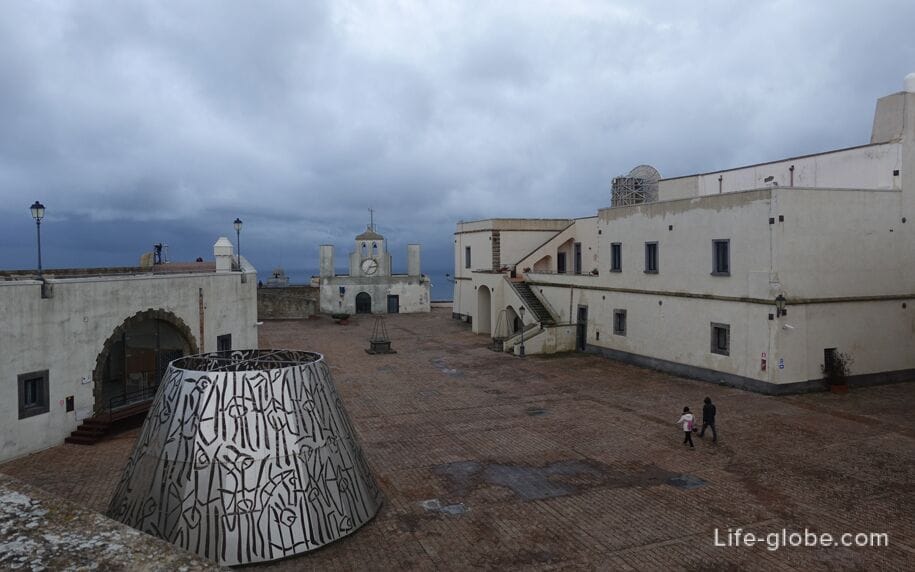
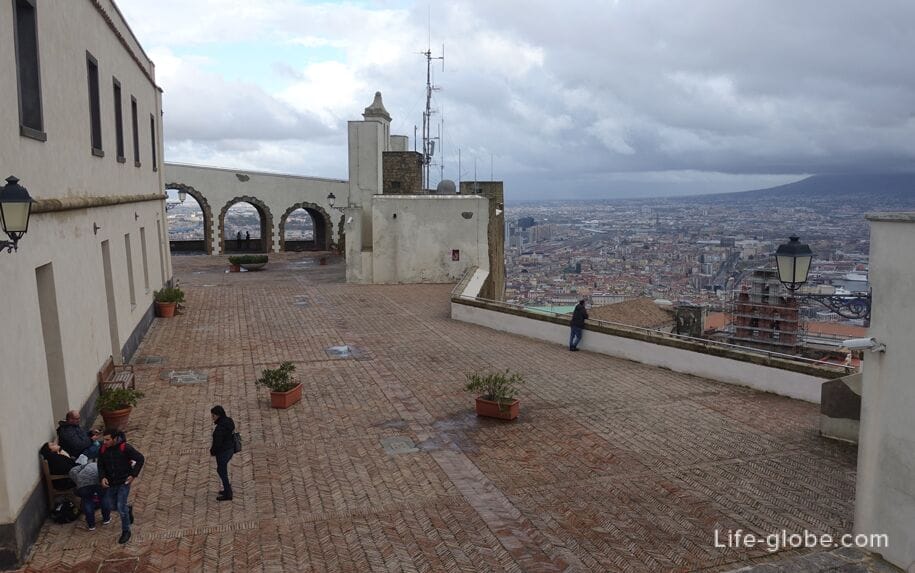
At the foot of the castle are: the viewpoint and former Carthusian monastery Certosa di San Martino (Certosa e Museo di San Martino), which operates the Museum.

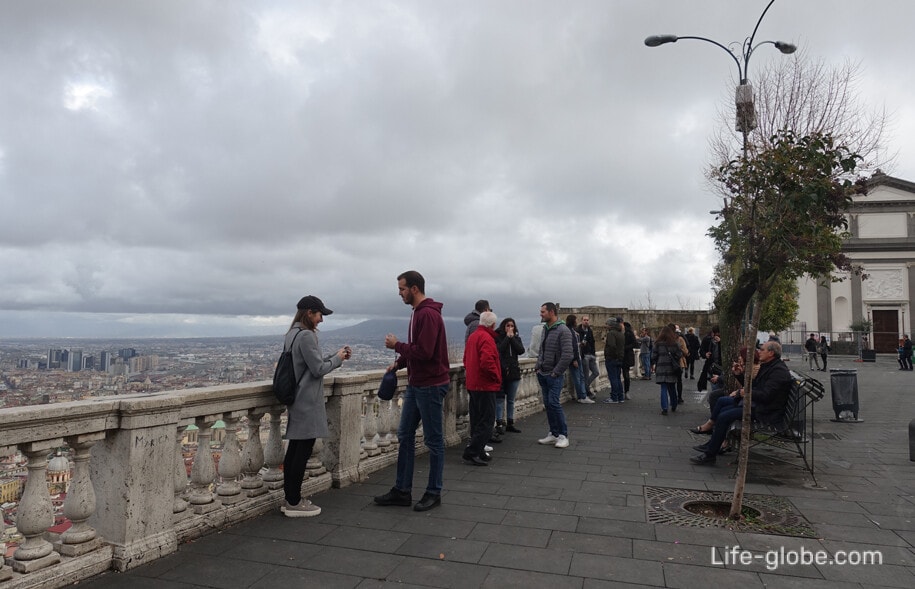
Panoramic staircase Pedamentina (Pedamentina San Martino)
Notable street Pedamentina first of all, that is a ladder, say, consisting of 414 steps, running along the slope of the Vomero hill and connects Naples historical centre, with the former monastery Certosa di San Martino and Castel Sant Elmo.
The street is fully pedestrian, built many centuries ago and today has retained its elegance. Read more about ladder Pedamentina...
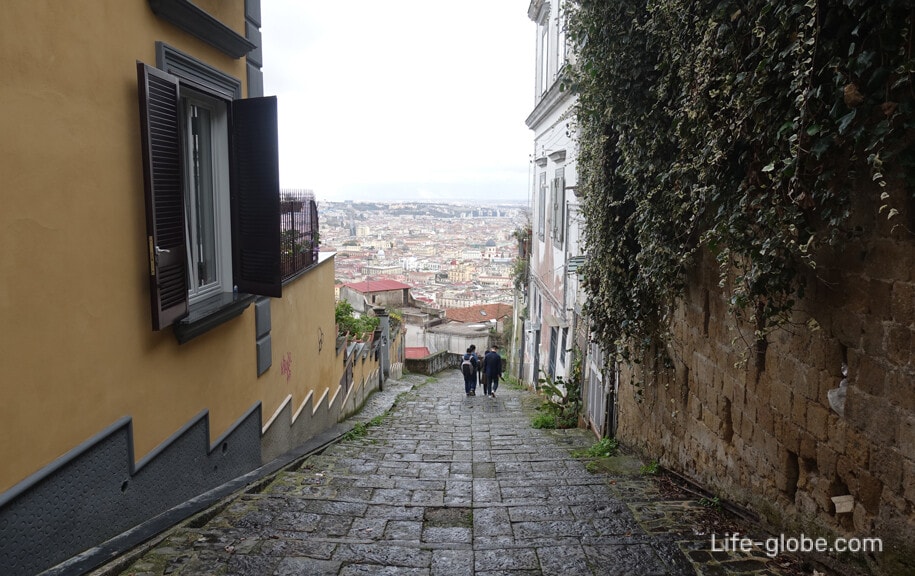
Castel Capuano (Capuano Castel)
Castel Capuano was built in the mid 12th century, is of Norman origin and was named "Capuano" due to the fact that is close to the old city gate of Porta Capuana (Porta Capuana).
The castle was extended by Frederick II and became one of his Royal palaces.
In the 16th century the Castel was the Hall of justice. In order to adapt the castle to new features, it was rebuilt in 1537: all the typical military structure was liquidated, the interior space was modified, and the basement converted into a prison with a well-equipped torture chambers.
In 1752, during the period of the Bourbons, was made of frescoes, and in 1857 - ' 58, the entire castle complex has been renovated, losing the traces of the ancient form.
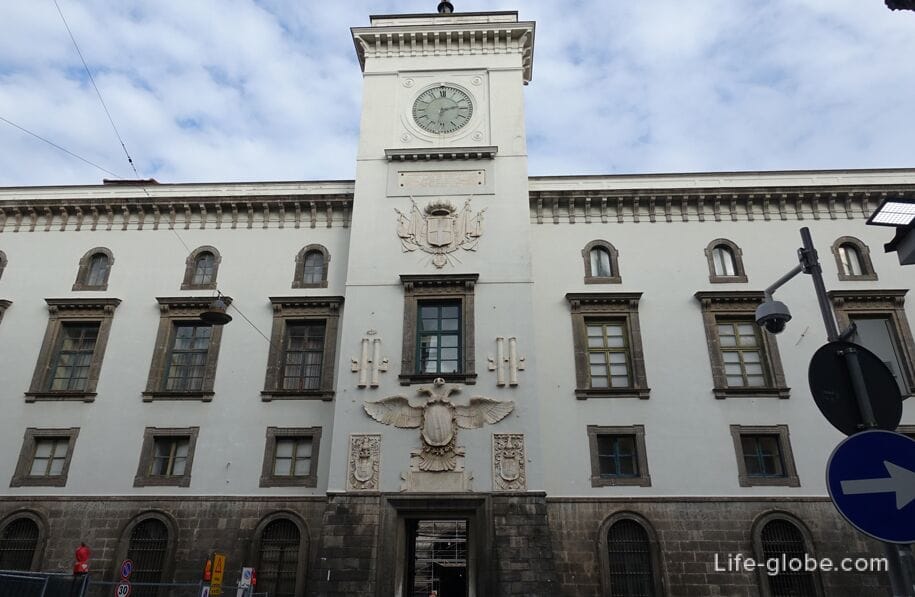
The Area Of The Municipality (Piazza Municipio)
The Municipality, also known as town hall square - one of the Central and largest squares in Naples.
The area has an irregular rectangular shape, is surrounded by interesting historical buildings, stretches from the city hall (Saint Giacomo Palace) to the Maritime station (Stazione Marittima).
One of the impressive sights in the town hall square and the undoubted attraction stands the monumental fountain of Neptune (Fountain of Neptune) was built between 1600 and 1601 years. Read more about hall square in Naples...
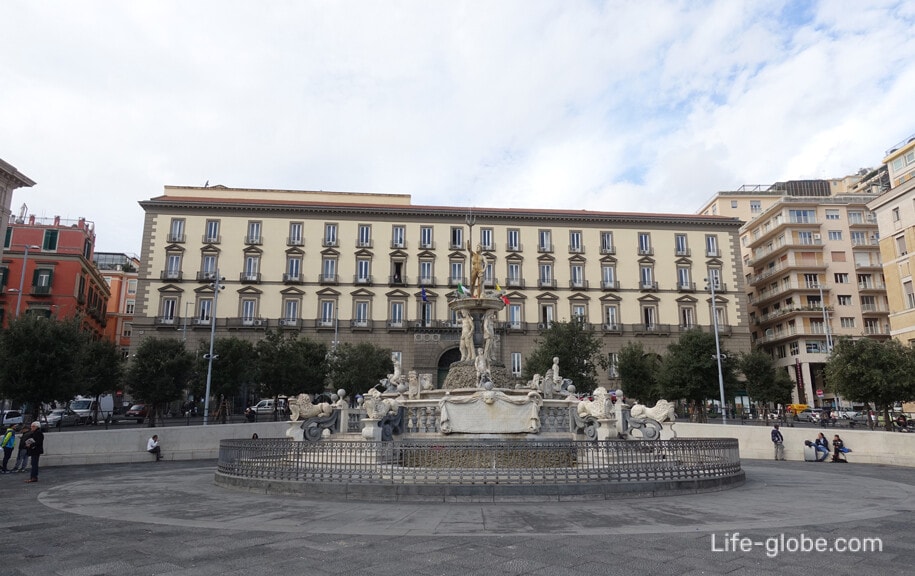
Cathedral of Naples (Cathedral Santa Maria Assunta)
Cathedral of Naples, also known as the Naples Cathedral (Duomo di Napoli, Cattedrale di San Gennaro), the modern name - the Cathedral - the main Church of Naples is a Roman Catholic Cathedral, consecrated in honor of the city's patron, St. Januarius.
Duomo di Napoli was commissioned by king Charles I of Anjou. Construction continued during the reign of his successor Charles II, and was completed only in the early 14th century under Robert of Anjou.
During its existence, the Cathedral has undergone repeated restructuring and renewal, resulting in the architecture of the Cathedral there are several styles: Gothic, Renaissance, Baroque and neo-Gothic. The last major reconstruction of the façade occurred at the end of the 19th century.
The main attractions of the Cathedral is the Royal chapel "the treasure of Saint Gennaro" and the crypt of San Gennaro. And the oldest part of the Cathedral stands the Basilica of Santa Restituta (Santa Restituta Basilica di) leading to the oldest surviving part of the structure is the baptismal of St. John (Battistero di San Giovanni in Fonte). Read more about the Cathedral of Naples...

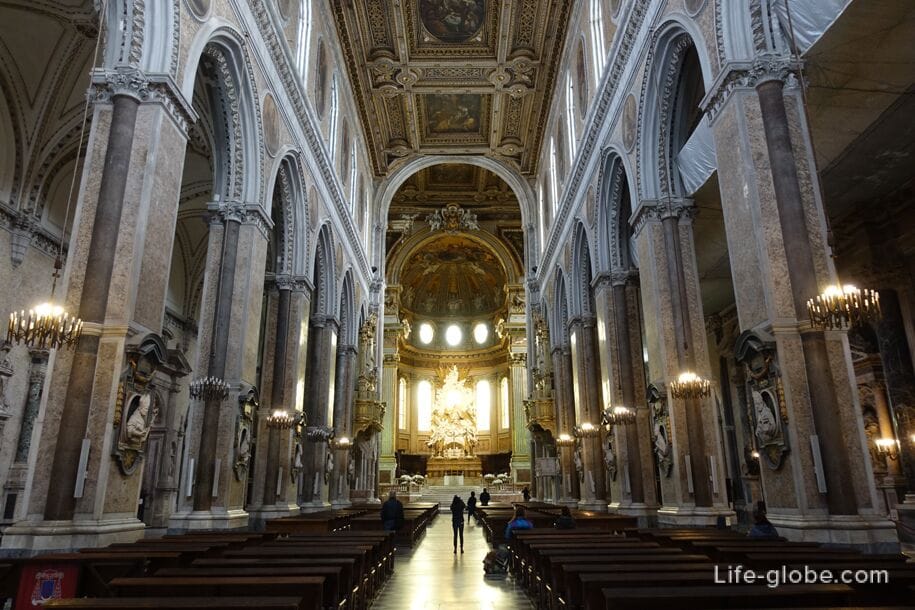
The square of gesù Nuovo (Piazza del Gesu Nuovo)
The Piazza gesù Nuovo, in Italian - the area of the New Jesus - one of the most important and famous squares and one of the symbols of the historical centre of Naples.
This area is the result of the expansion of the city to the West, since the beginning of the 16th century.
In the centre of the square stands a 30-metre marble obelisk of Jesus, also known as the obelisk of the Immaculate Conception (Immacolata de l Obelisque) is one of the best examples of Baroque sculpture in Naples.

On the West side of the square are the late Baroque historic palaces such as Palazzo Pandola and Palazzo Pignatelli di Monteleone.
On the East side there are some of the most important churches in the city:
Church of gesù Nuovo (Chiesa del Gesu Nuovo), which was originally a Palace built in 1470. The construction of the Church began in 1584. The new Church retained the unusual facade, lined with rustic diamond lugs;
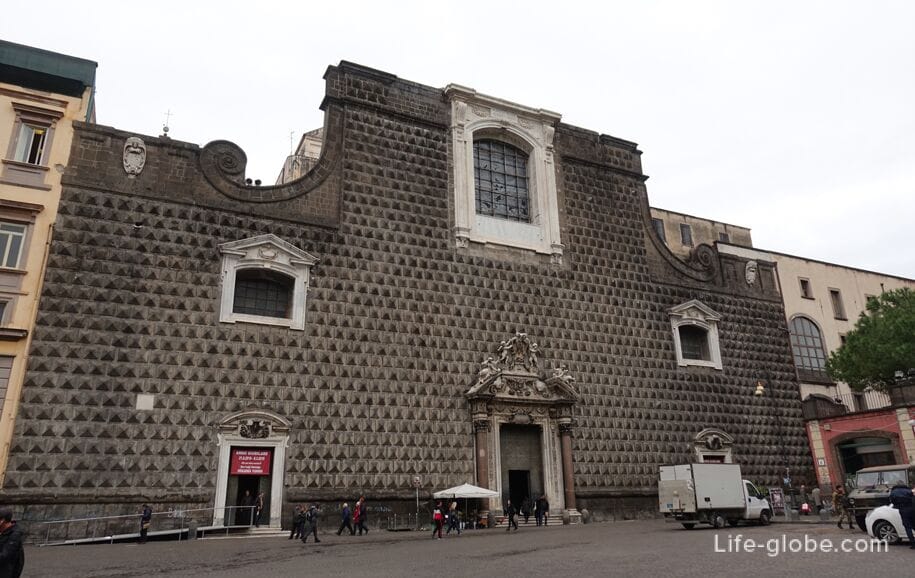
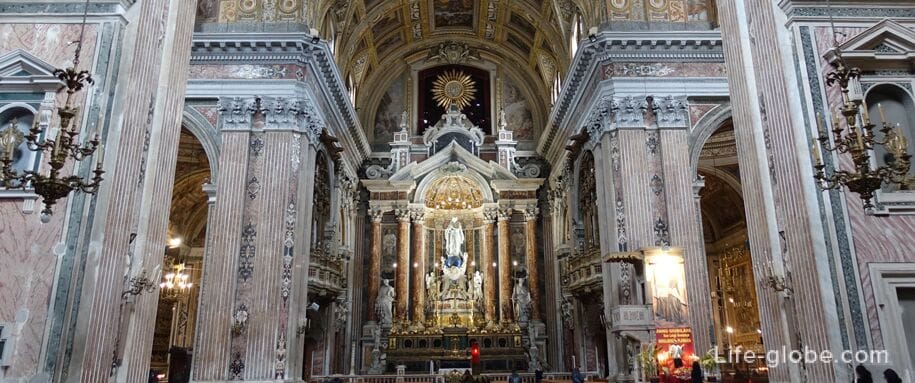
- the Basilica and monastery of Santa Chiara, or Saint Clare (Santachiara Monastero Clarisse) are a religious monumental complex, whose construction began in 1310, at the behest of king Robert of Anjou and his wife. The citadel was constructed by building two monasteries: one for the poor, the other for the Franciscan monks.
Today the complex is presented in its original Gothic forms, with a simple facade, typical Trecento.
The monastery of Santa Chiara is notable for visits primarily a courtyard with a roofed gallery around the perimeter, two lanes, crossing the garden, he divided the last into four sectors.
Inside the building there is a Museum which houses some remarkable things survived the explosion 1943 and archaeology - Roman baths, Dating from the first century ad. Read more about the square of gesù Nuovo in Naples...
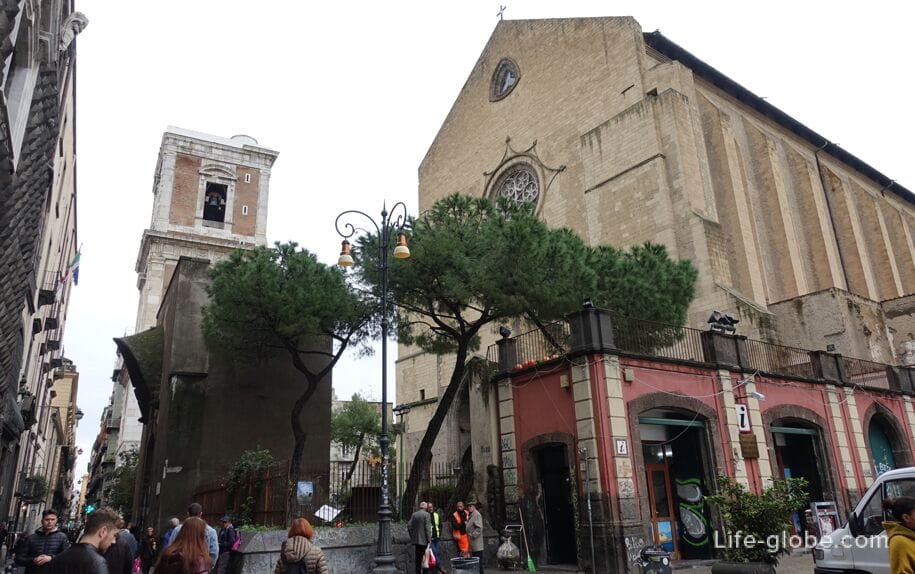
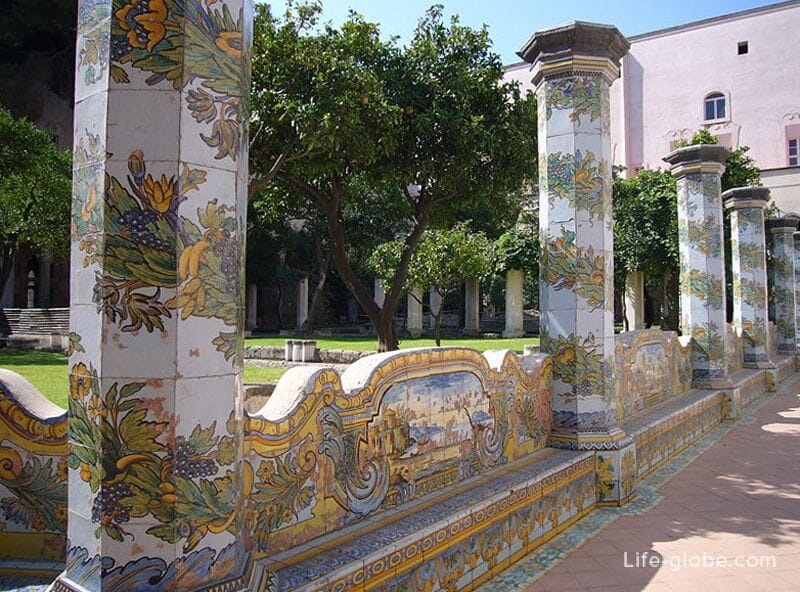
Piazza San Domenico Maggiore (Piazza S. Domenico Maggiore)
The main dominants of the square are: the namesake Church of San Domenico Maggiore (San Domenico Maggiore) and the obelisk rising in the centre of the square in memory of the plague epidemic.
The Church of San Domenico Maggiore is part of the former Dominican monastery complex and one of the main churches in Naples. The apse of the Church faces the square.
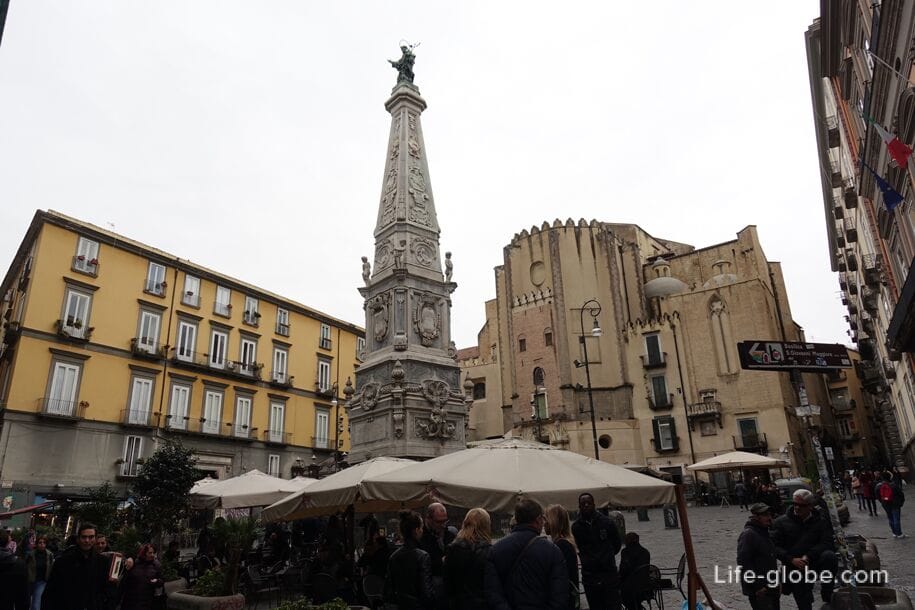
Street Spaccanapoli (Spaccanapoli)
Spaccanapoli, a narrow street crossing the historical centre of Naples from the southwest to the northeast.
Its roots in the street takes from the Greco-Roman era. This street you won't find on the maps, officially it consists of several independent streets, smoothly flowing into one another.
Today the morning is an invisible vein of the city; - the place where the main tourist routes in Naples; - the abundance of cafes, small restaurants and taverns, small shops and souvenir shops.
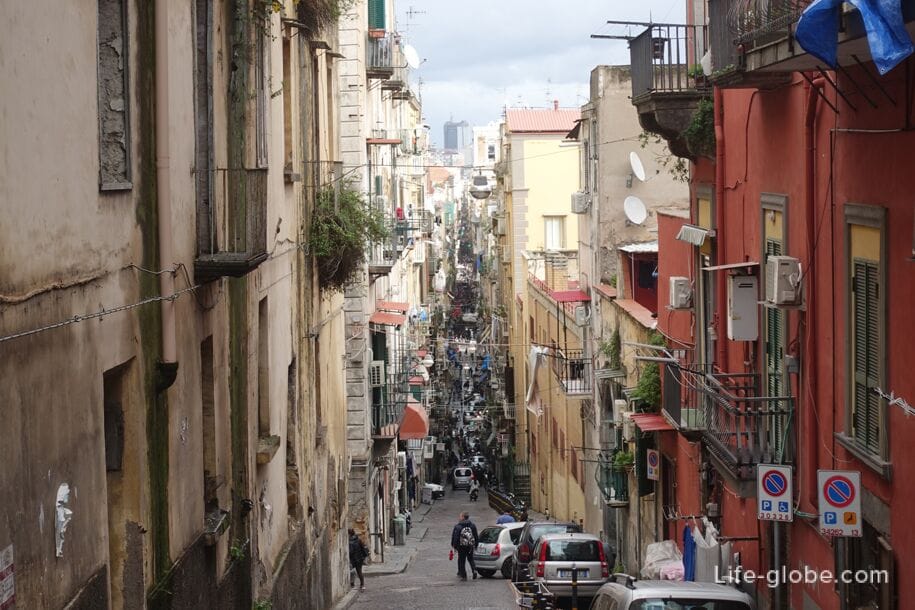
The street is also notable for its churches, important buildings and small squares, among which are:
- the Roman Catholic Church of the 18th century Santa Maria de Sette Dolori (S. Maria ad Ogni Bene dei Sette Dolori);
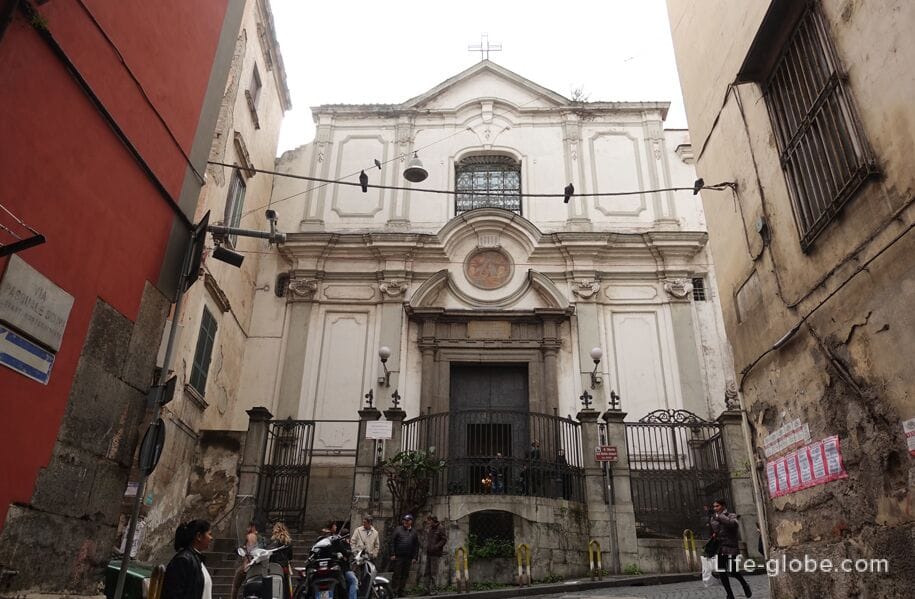
- Palazzo Venezia or the Venice Palace (Palazzo Venezia), the premises of which are currently used for exhibitions and events. Part of the building can be visited free of charge. Also in the Palace are the courtyard and garden, a souvenir shop and cafe tables which are placed on the wide balcony;
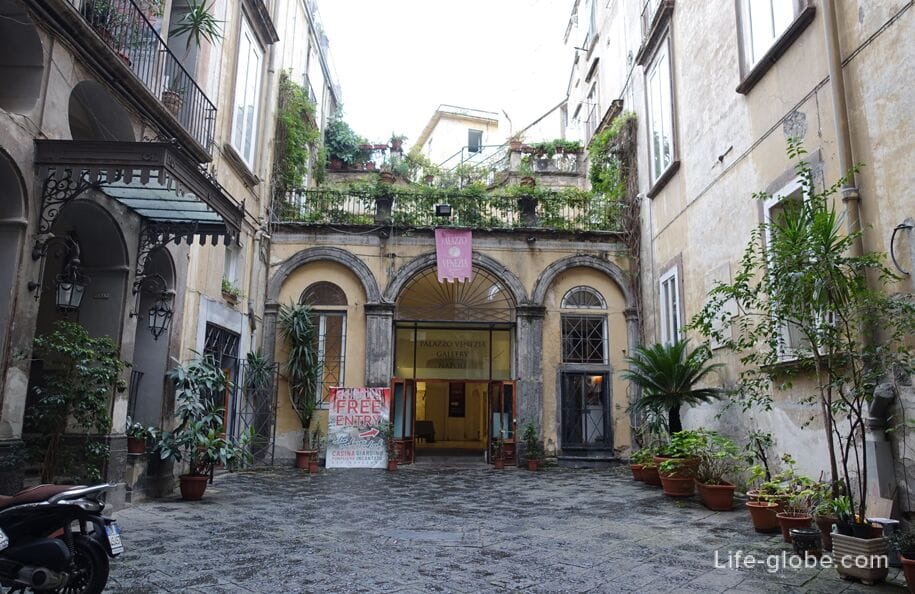
- the area of Nilo (Piazzetta Nilo), which received its name from the statue of the God Nile;
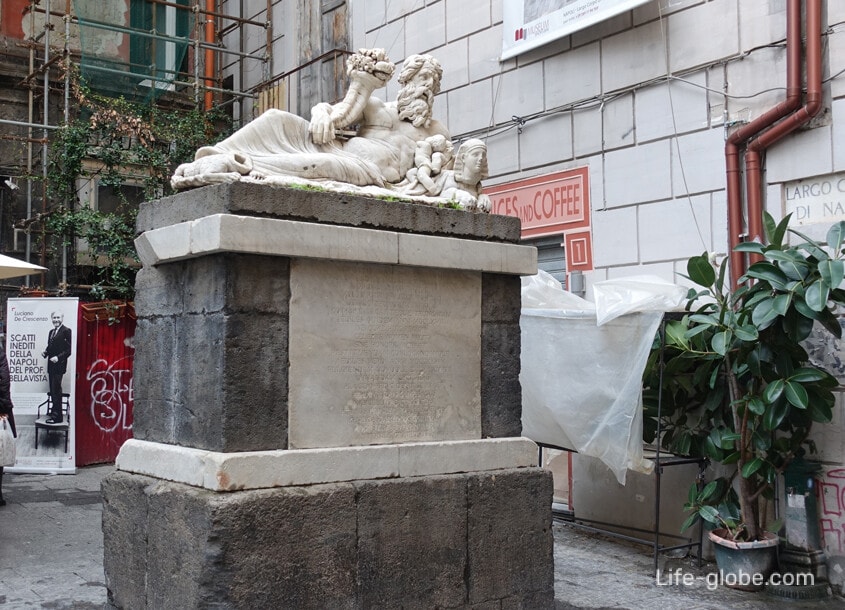
Church of Sant Angelo Nilo (Chiesa Sant'angelo a Nilo), inside which are the tombs of members of the Brancaccio family, including one of the most prestigious works of the city - the monumental tomb of cardinal Rainaldo Brancaccio, created by Donatello and Michelozzo. Read more about Spaccanapoli street Naples...
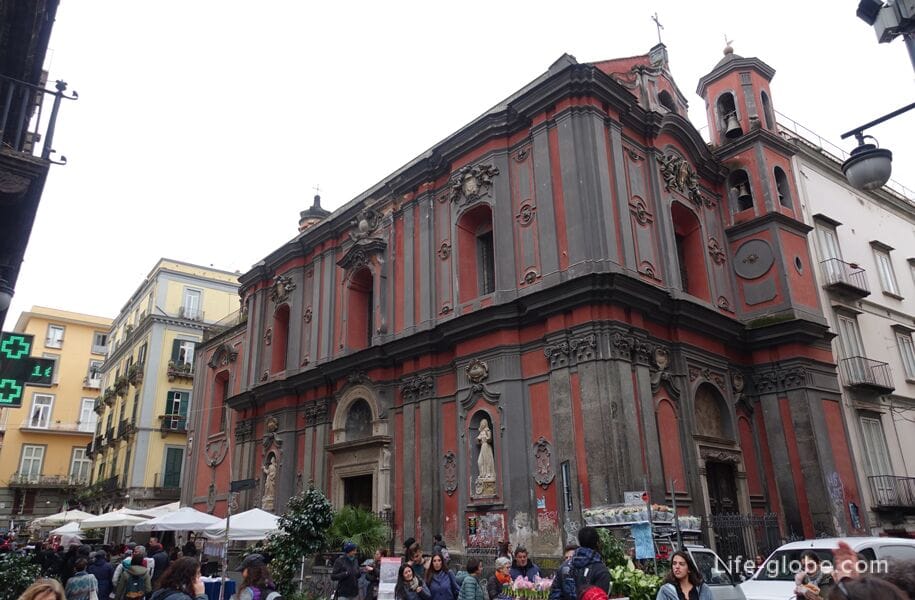
The Church Of San Gregorio Armeno (San Gregorio Armeno)
Or the Church of St. Gregory of Armenia Church and convent, is one of the most important Baroque complexes in Naples, built in the 10th century on the ruins of a Roman temple dedicated to Ceres, by a group of nuns fleeing from the Byzantine Empire with the relics of St. Gregory, Bishop of Armenia.
During the Norman domination the monastery was United to the monastery of the Salvatore and San Pantaleone, adopting the Benedictine rule.
The construction of the present Church was begun in 1574 under the project, Giovanni Battista Cavagni and consecrated five years later. Later the consecration dates back to 1674 and reconstruction - 1762.
In the interior of the Shrine is the famous Holy staircase, used by the nuns during the time of repentance. And the courtyard of the monastery is decorated with a large marble fountain.

The Sansevero Chapel (Cappella Sansevero)
In the past, the private chapel and the tomb of the noble family of Sangro, which bears the title of Prince of San Severo.
The chapel contains works of art by some of the leading Italian artists of the 18th century, as well as numerous marble tombstones, representing various allegories of the virtues. Currently operates as a Museum.
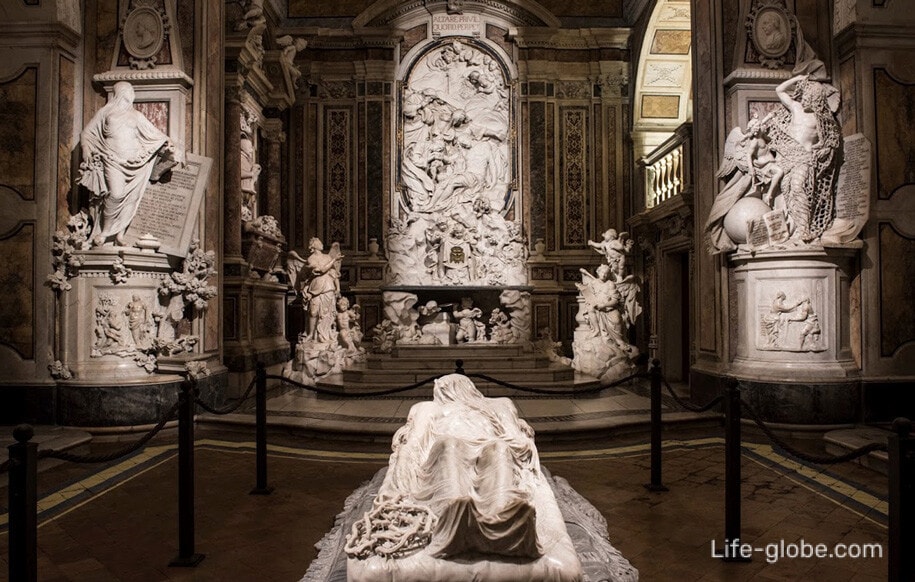
The Church of San Lorenzo Maggiore (Complesso monumentale di San Lorenzo Maggiore)
The Church and convent in Naples, consecrated in honor of St. Lawrence. The existing Church was founded by Franciscan order in 1265. The monastic complex was built in the second half of the 18th century and completely rebuilt by the architect Sanfelice in 1742.
In the chapels of the relics are: the tomb of Catherine of Austria, a statue of the work of Tino da Camaino (1323), and also frescoes.
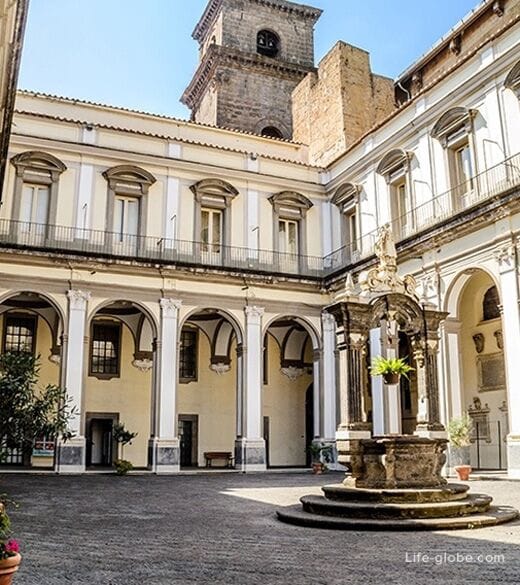
Under the Church is the archaeological complex "Buried Neapolis" (Neapolis Buried), located in the place where once stood the Agora - the living space of the Greek city, which later became the Roman forum.
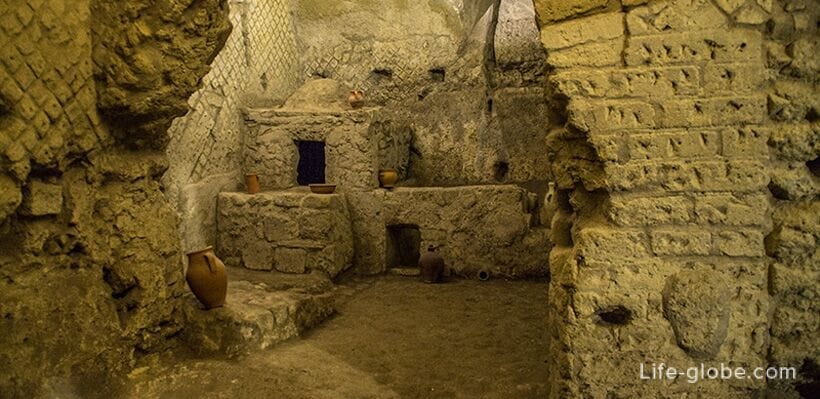
The Basilica Of San Paolo Maggiore (San Paolo Maggiore)
Church in Baroque style was erected on the ruins of the temple of the Dioscuri of the 1st century.
The Basilica was built in the 8th and 9th centuries, dedicated to St. Paul to celebrate a victory in 574 year of the Neapolitan Duchy over the looting of the Saracens.
The Basilica, which can be seen today, was erected in 1538, with further improvements and alterations.

Museum Of Underground Naples (Napoli Sotterranea)
To the left of the Church of San Paolo Maggiore and the entrance to the Museum "Underground Naples".
The tour includes a visit to the Greek tuff quarries, the ancient aqueduct, underground tanks and tunnels of the Roman era and the remnants of the Greco-Roman amphitheatre.
During the Second world war the cave was used as bomb shelter, therefore, under the bowels, you can see a tank and military Museum of Naples.
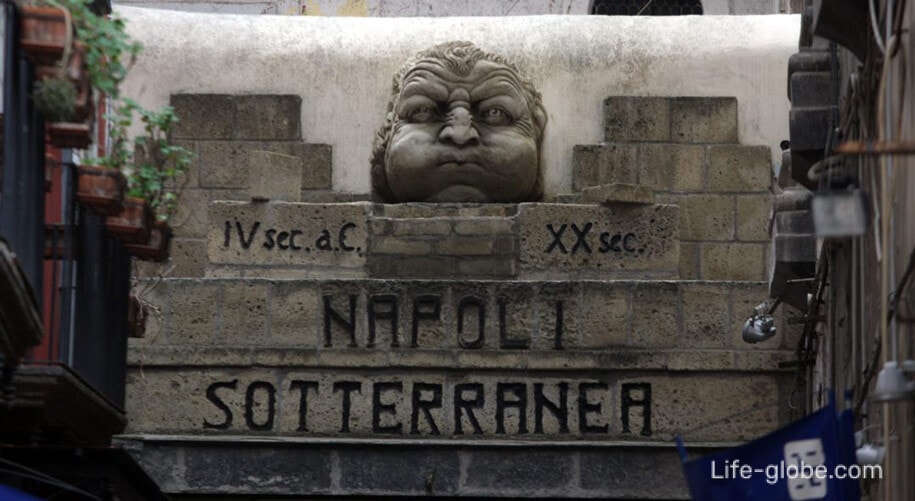
Archaeological site of Carminiello ai Mannesi a Napoli
Located in the city center and consists of the remnants of the complex of baths of the Roman era Dating from the late 1st century BC.
During the excavations of the thermal baths, several reservoirs and marble relief representing the deity Mithras in the act of sacrifice of a bull.

The Mercato Square (Piazza Mercato)
Piazza del Mercato in the translation Market square is one of the largest and most neglected areas of Naples.
The current square is the place where he once cut the head - the place of public executions, starting from October 29, 1268 year and on 11 September 1800.
The area is particularly famous as the place where the revolt of Masaniello, who was born and lived in a house in the area, which, in his memory, since 1997, installed a sign with the epigraph.
The square is decorated with two fountains with obelisks of the 18th century (on the East and West sides). On the North side of the square is decorated Church of Santa Croce and Purgatory on the market (Chiesa di Santa Croce e Purgatorio al Mercato) released a large dome of green-yellow color.
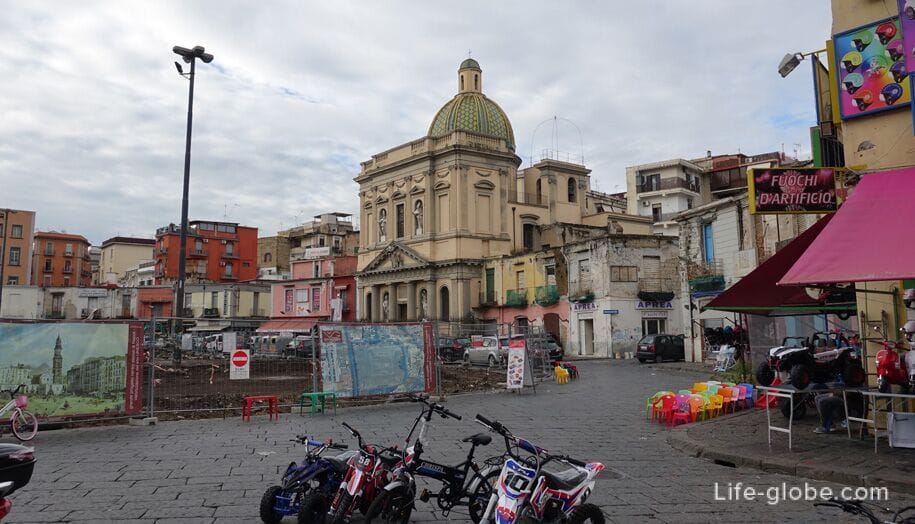
Church of Sant Eligio Maggiore (Chiesa di Sant'eligio Maggiore)
Near Piazza Mercato, is the original architecture of the Church of Sant Eligio Maggiore, which is an iconic building built in the Gothic style in the Angevin period (1270).
The Church was surrounded by the hospital, and the whole complex enjoyed Royal protection and privileges. The complex was struck and severely damaged by heavy bombing on March 4, 1943, and, after several decades of impressive restoration has returned the Church to its original Gothic lines, freeing him from shtukaturami used for centuries.
Remarkable and Arco di Sant Eligio (Arco di Sant'eligio) of the 15th century, rising on two floors, and serves as a connection between the bell tower of the Church with the neighboring building.
On the facade of the first floor arches are large watches.
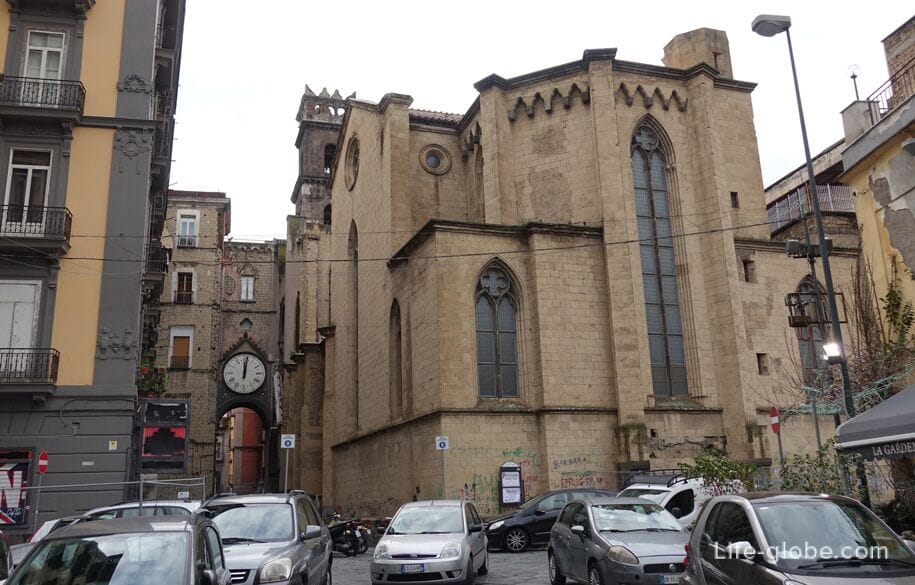
Piazza Dante Square (Piazza Dante)
Piazza Dante marks the end of the street of Toledo and is one of the most important squares in Naples.
The square features a metro station (Dante), and its center is decorated with a monument of Dante Alighieri (Dante Alighieri monument), outdoor July 13, 1871. In addition to Piazza Dante and close to such places several monumental churches.
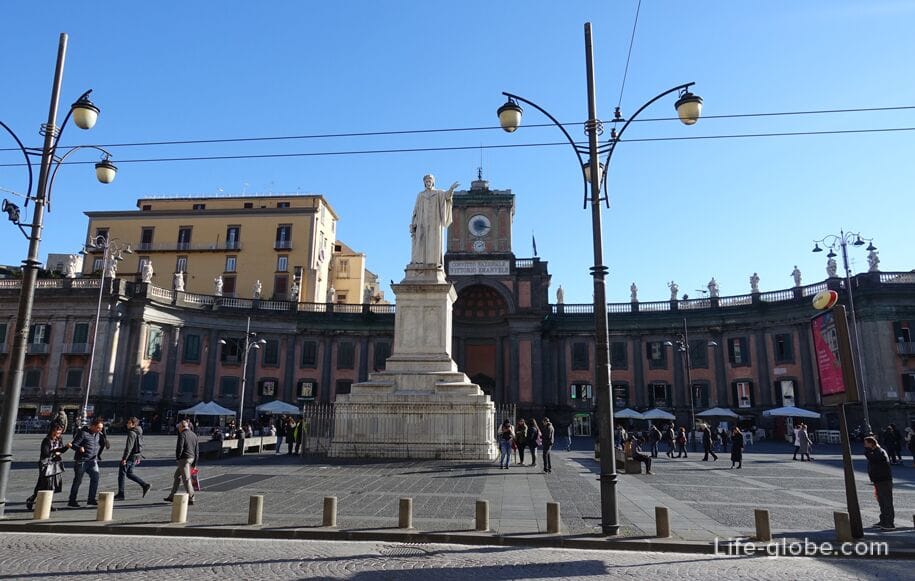
National archaeological Museum of Naples (Museo Archeologico Nazionale di Napoli)
Palazzo del Garda (Palazzo degli Studi) is a Palace in Central Naples, located on the Museumplein.
The construction of the building began in 1586 as cavalry barracks, then located outside the walls of Naples.
In 1612, the Viceroy don Pedro Fernandez de Castro, count of Lemos, decided to move into the unfinished building of the University of Naples ("Palazzo dei Regi Studi"). At the present time within the walls of the Palace houses the national archaeological Museum of Naples.
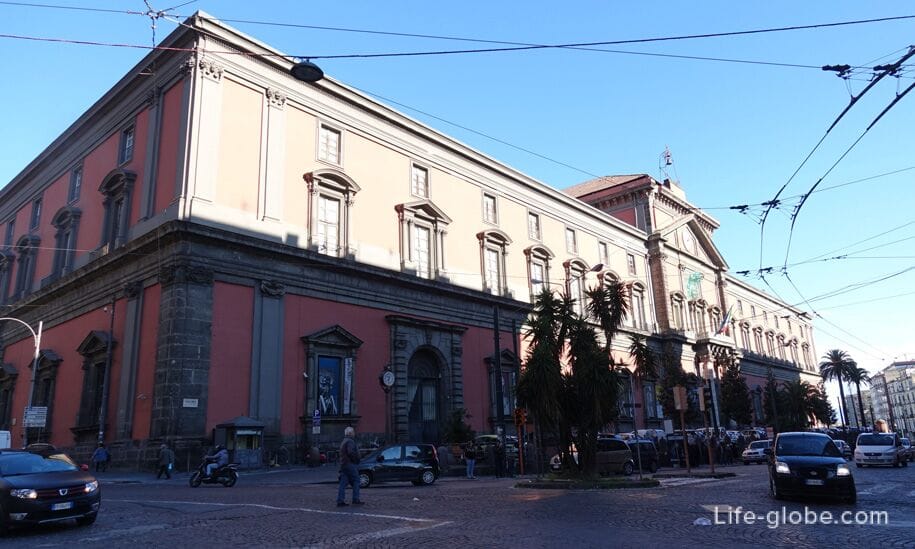
Capodimonte (Capodimonte)
The Park of Capodimonte (Capodimonte Park) - historic public Park located on the hill North of the centre of Naples.
Central to the Park is a historic Royal Palace of Capodimonte (Capodimonte Royal Palace) - the former summer residence and hunting Lodge of the kings of the two Sicilies, and one of the two Royal palaces in Naples.
Currently, the walls of the Palace is one of the largest museums of Italy - National Museum and gallery of Capodimonte (Museo e Gallerie Nazionali di Capodimonte).
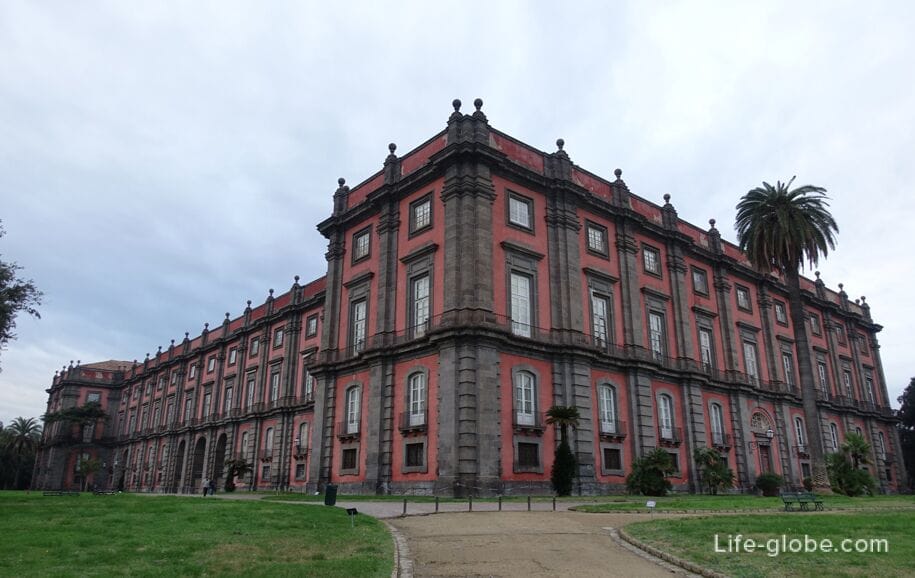
Also Capodimonte Park historical Belvedere fountain (Fontana del Belvedere), built by order of Umberto I of Savoy. Near the fountain is a lookout point Belvedere, with views of part of Naples Gulf of Naples and the surrounding area.
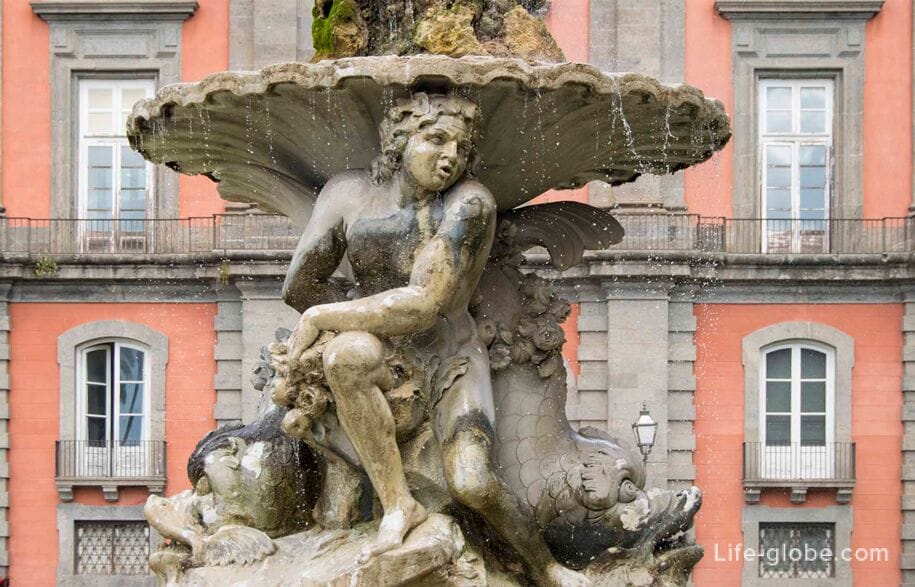
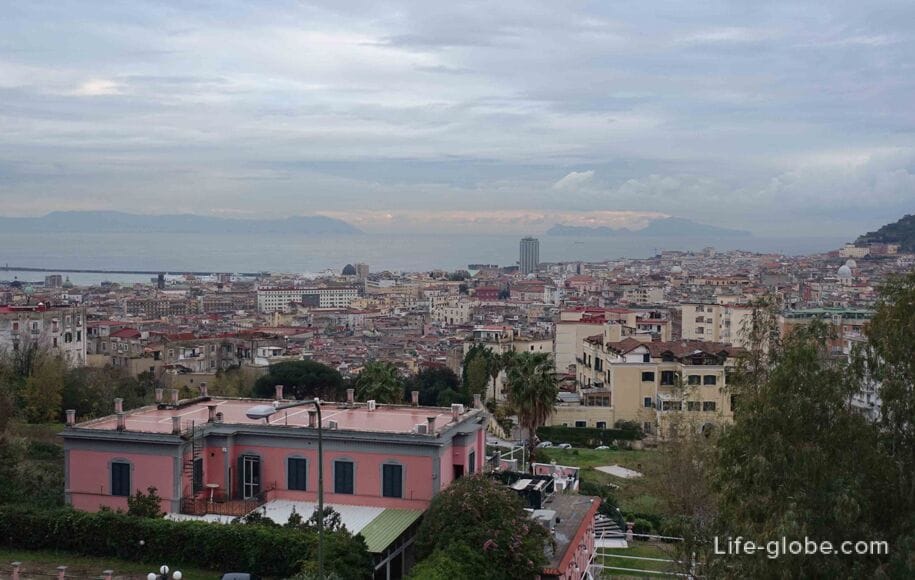
In the Park are 6 main routes passing through the most sensitive area of garden Capodimonte. Along the way: statues, places to stay and historic buildings for various purposes. Read more about pair of Capodimonte in Naples...
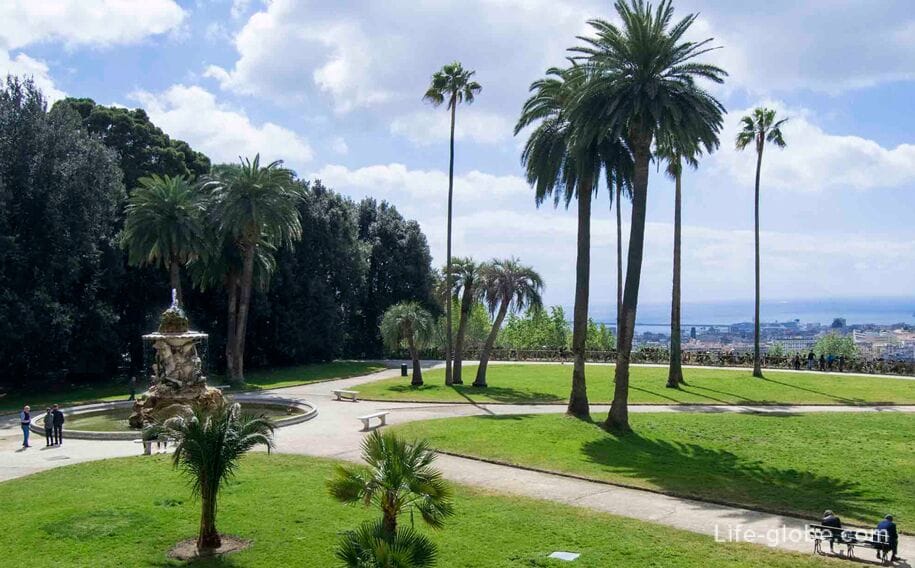
The catacombs of San Gennaro (Catacombe di San Gennaro)
Or the catacombs of St. Gennaro, the largest Christian catacomb complex in southern Italy and one of the oldest cemeteries of the early period of Christianity, the core of which dates back to the 2nd century ad.
The catacombs of San Gennaro are located on two disjoint levels, characterized by wide spaces and two underground basilicas.
At the bottom of the catacombs the remains of Sant Agrippina - the first patron Saint of Naples, over the tomb which was carved underground Basilica. Also in the bottom catacombs are: the impressive lobby with high ceilings, containing a bath for the baptism and a dense network of tunnels on both sides which houses the burial.
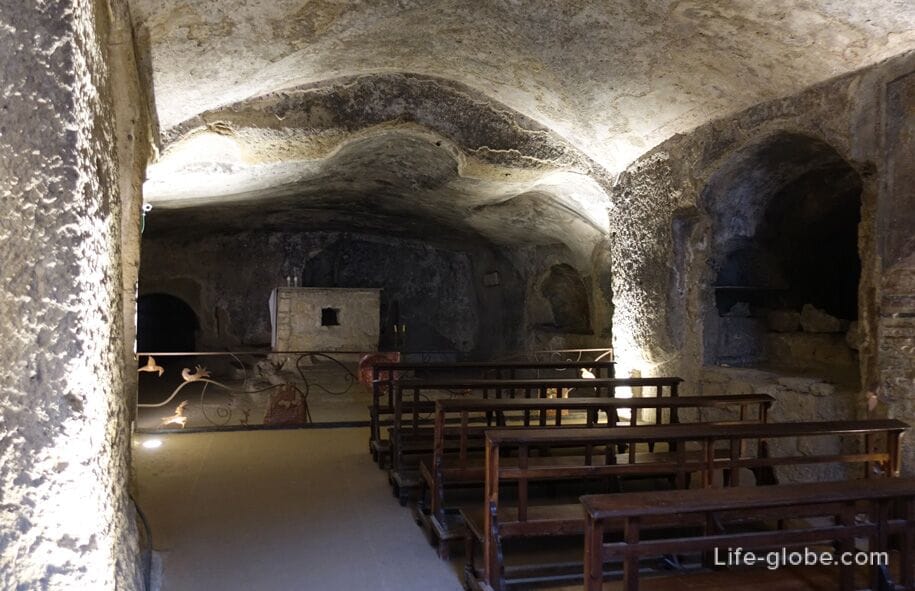
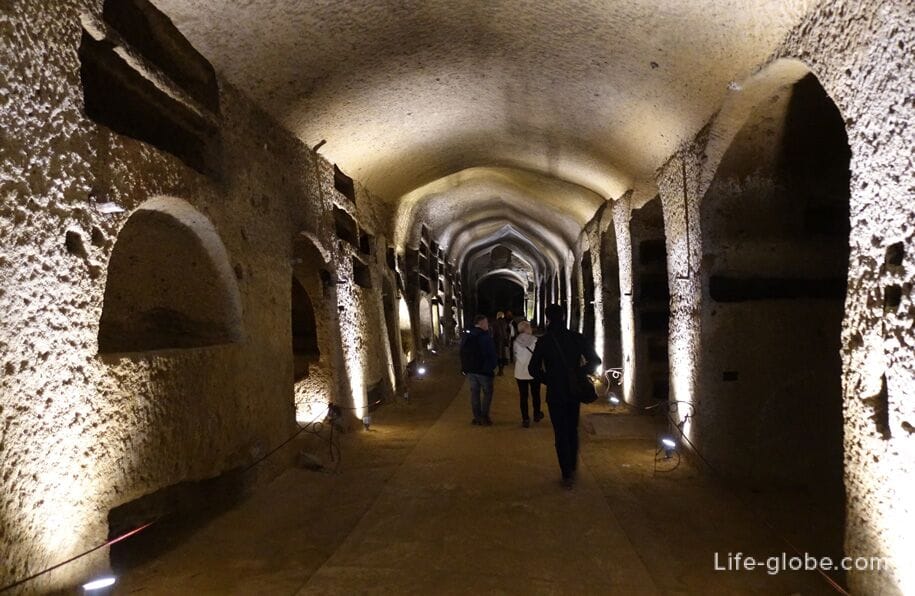
The upper part of the catacombs - the place where they were transferred the remains of San Gennaro (St. Januarius) is the Martyr, the patron Saint of Naples. In the upper part are also spacious corridors, the Crypt of the bishops where they were buried bishops of the city, and which extended to a higher level, around the tomb of San Gennaro and the Basilica with three naves, built to commemorate the transportation of the remains of San Gennaro in the catacombs. Read more about the catacombs of San Gennaro...
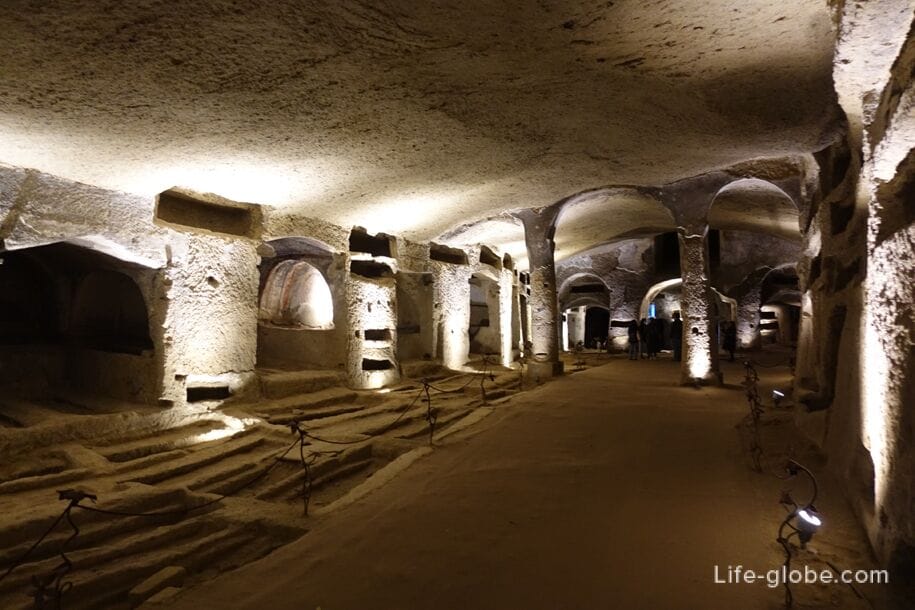

Catacombs of San Gaudioso (Catacombe di San Gaudioso)
Above the catacombs, between 1602 and 1610 was built the Basilica of Santa Maria della Sanita (Basilica di Santa Maria della Sanità), which is currently being access to the catacombs of San Gaudioso.
In the catacombs were buried St. Gaudioso - Bishop of North Africa, exile, stayed in Naples and lived in town until his death. The burial took place between 451 and 453 years, after which the place became the object of veneration and known under his name.
Since then the catacombs have been expanded, and from 17 in the catacombs were placed mainly graves of aristocrats and priests. Read more about the catacombs of San Gaudioso...
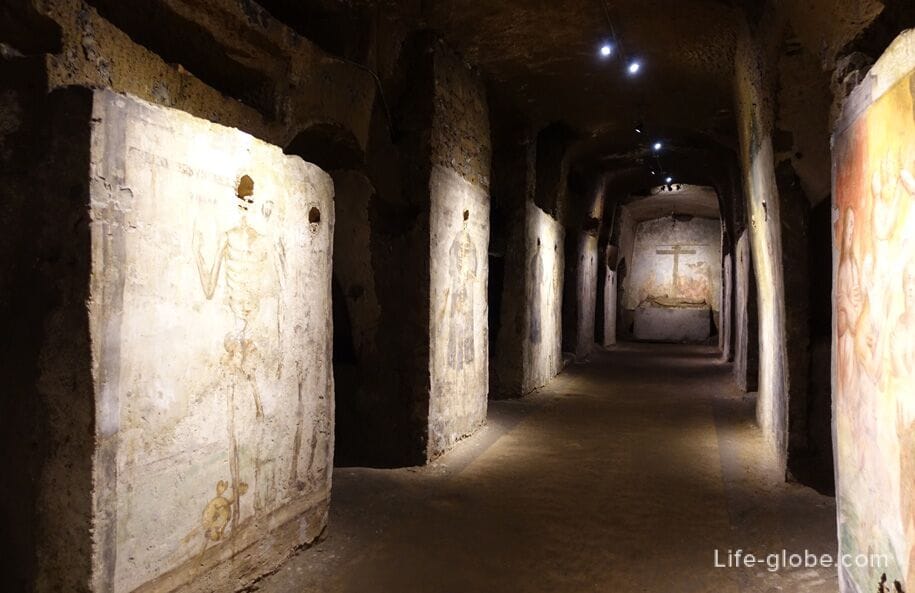

The Bridge Of Maddalena (Ponte Maddalena Cerasuolo)
One of the oldest bridges of Naples, formed large arches.
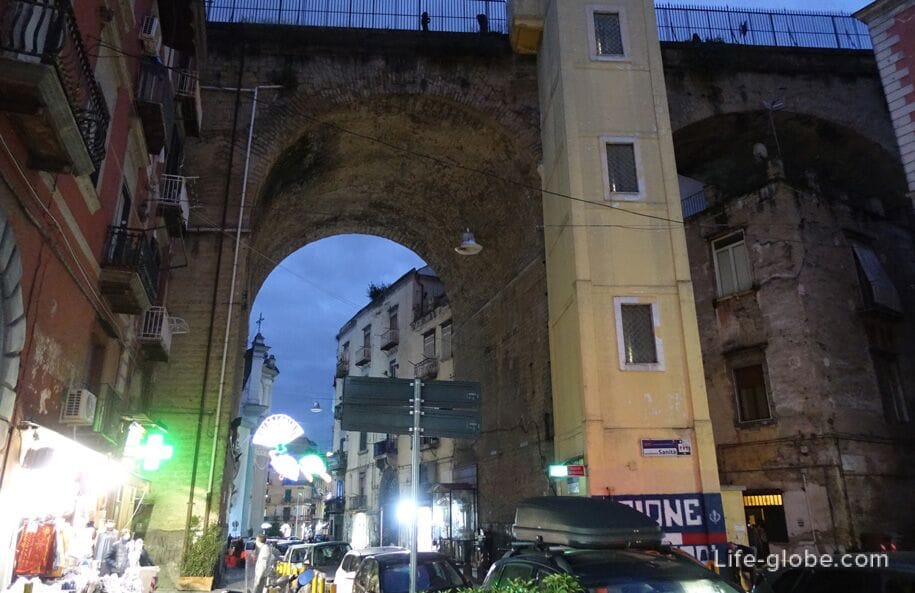
Fontanelle Cemetery (Cimitero Delle Fontanelle)
The ancient cemetery of Naples, is currently not used for its intended purpose and which is a crypt where are the skeletal remains of people.
The cemetery is located in the cave in the tuff rock, consists of three large tunnels trapezoidal cross-section connected by side corridors (passages), each of which has its own name.
The left corridor is called the passage of the priests because in it are the remains coming from the territories of the churches and parishes; the Central nave is called the passage of the plague, because it contains the bones of those who died because of the terrible epidemics; right of passage called the nave percentile - it was collected the bones of the poor.
The sides of each aisle are fenced, which contains the skull, the large tibia and the femur. Many bones and skulls just piled in heaps, while others are in boxes. Read more about cemetery of Fontanelle...
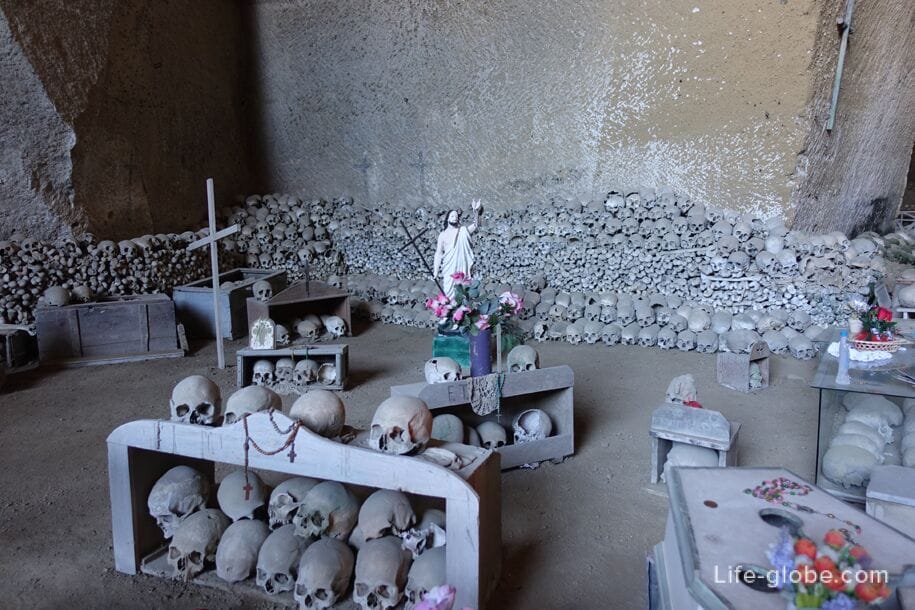
Villa Pignatelli (Villa Pignatelli)
The Villa was built for Ferdinand Acton in 1826 as a neoclassical residence. Outside the Villa you will find a garden and domestic premises is a Museum (Museo Pignatelli).
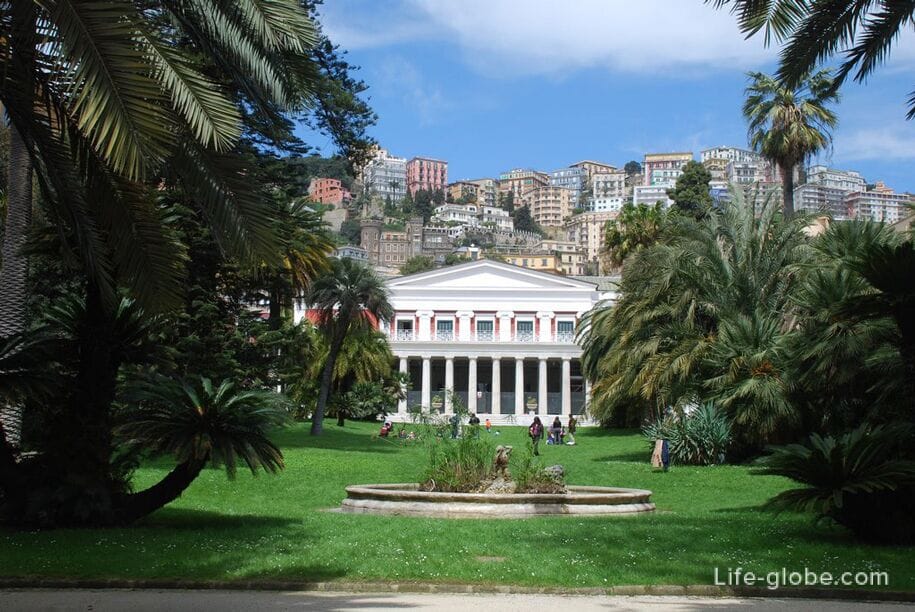
Villa Floridiana (villa Floridiana)
A historic building surrounded by a Park, located on the Vomero hill. The Villa was built between 1817 and 1819 years, after Ferdinand I of the House of Bourbon, King of the two Sicilies, acquired the property.
The Villa is currently a decorative arts Museum Duca di Martina, and with a small panoramic terrace Floridiana (Terrazza Panoramica Villa Floridiana) views of the centre of Naples, the hill of Posillipo and the Bay of Naples. This viewpoint is considered to be one of the best in the city.
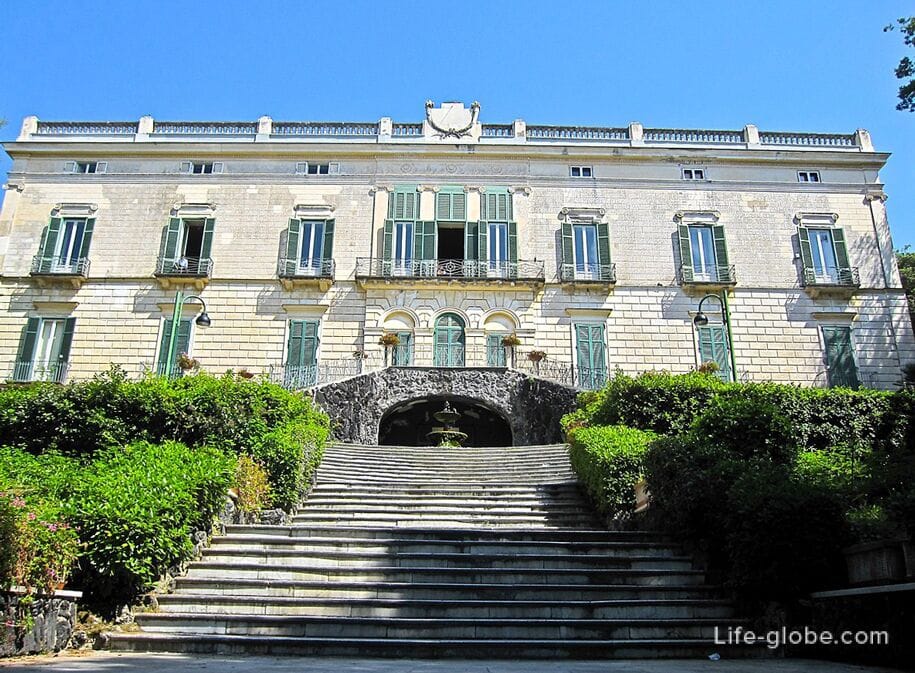
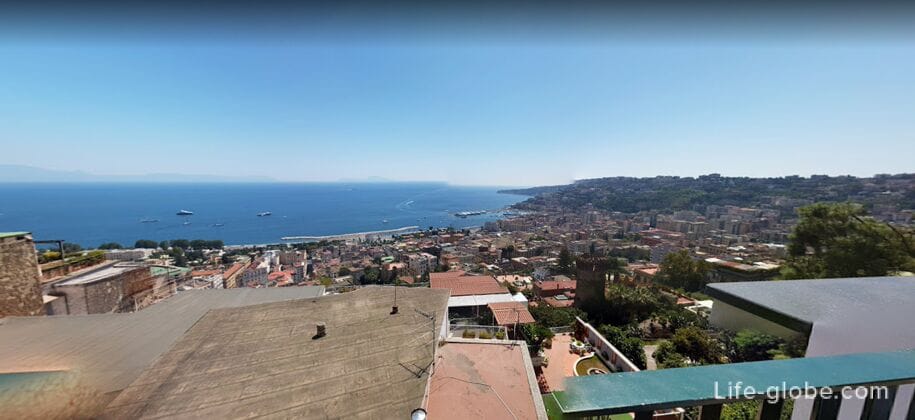
Belvedere Sant'antonio Posillipo (Belvedere Sant'antonio a Posillipo)
The observation deck, situated just above the harbour of Mergellina.
Playground is set next to the homonymous Church (Chiesa di Sant'antonio a Posillipo) and it becomes one of the most spectacular panoramic views in Naples. Clearly visible is the Marina of Mergellina, part of the city and Vesuvius. Read more about observation deck of Naples...
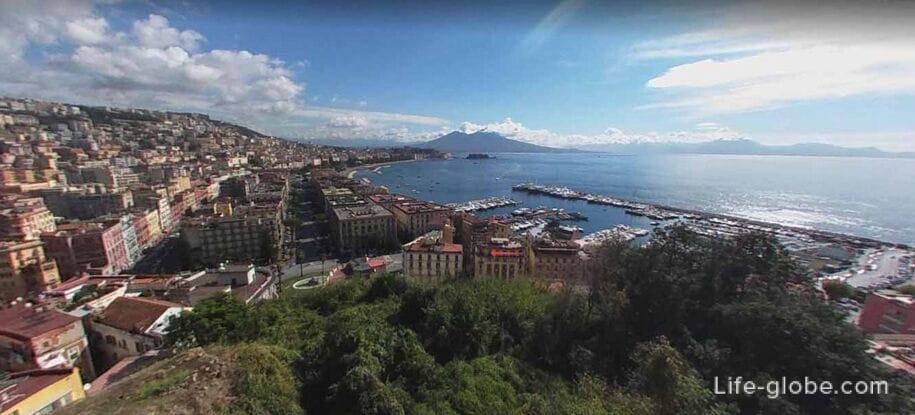
The embankments and the coast
The waterfront of Naples is one of the favorite places for walking and recreation as among local residents so among city guests.
The main attractions of the coast of Naples are:
statue of Umberto I;

- The Giant fountain (Fountain of the Giant) - treharne delicate structure, decorated with sculptures and designed in the 17th century for the Royal Palace of Naples;

- Mergellina harbour and Sant Nazzaro (Nazzaro and Saint Mergellina Harbour), lined with taverns and restaurants. The road along the Marina is called the promenade of Mergellina;
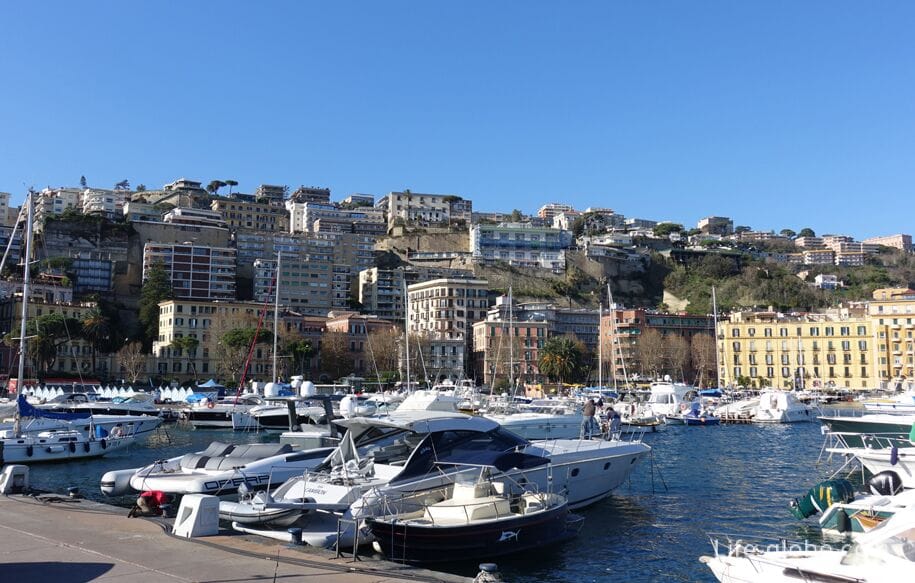
- Sebeto fountain or Fontana del Sebeto (Fontana del Sebeto), built in 1635 at the direction of the Viceroy Emanuele de Fonseca;
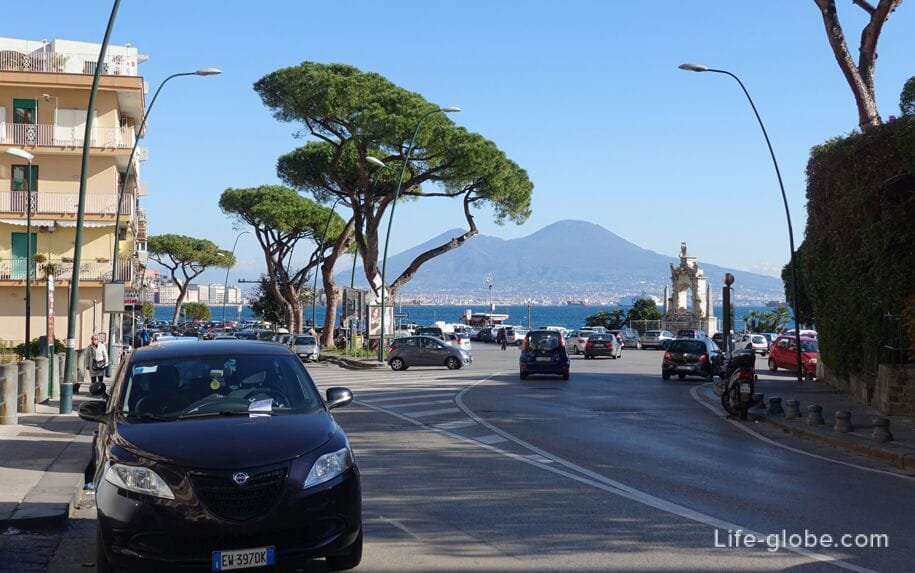
Palace of Donna Anna (Palazzo donn'anna) - a historical monument of the 17th century;

Villa Rosebery (Rosebery Villa), one of three official residences of the President of the Italian Republic. The Villa is called "Rosebery" since they belonged to the British Prime Minister, the 5th Earl Rosebery.
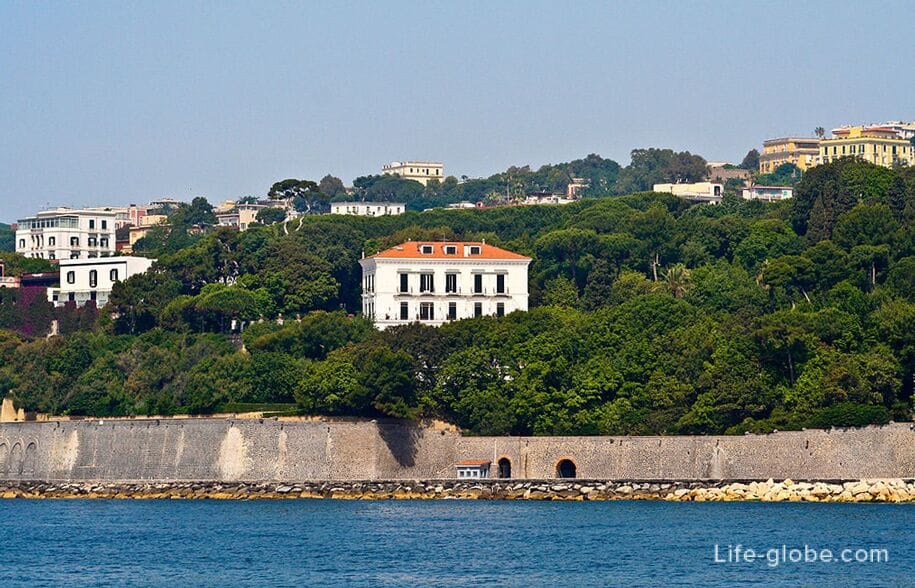
In addition to the above, the coast of Naples is famous for the coast of the hill of Posillipo, representing some of the best of Naples in Naples, Vesuvius and the surrounding area. Read more about the coast and the beaches of Naples...
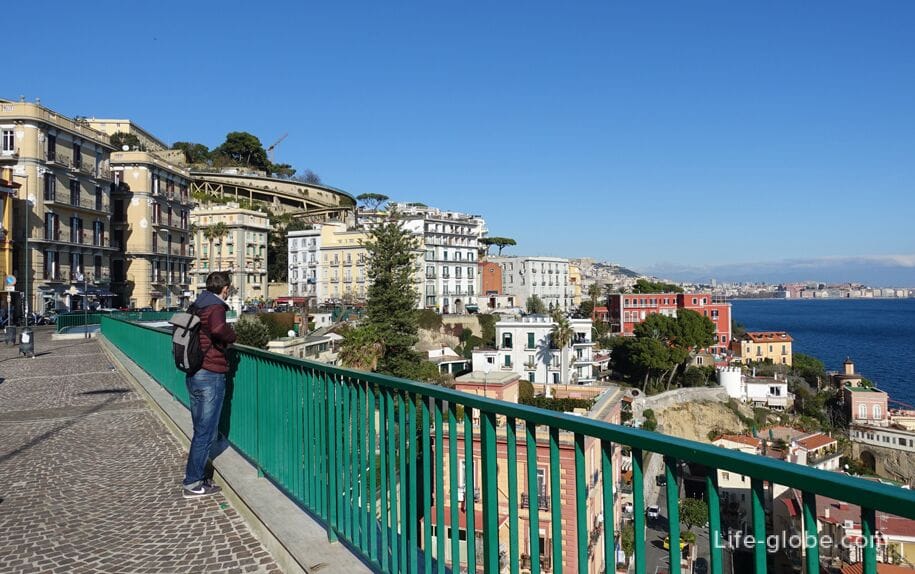
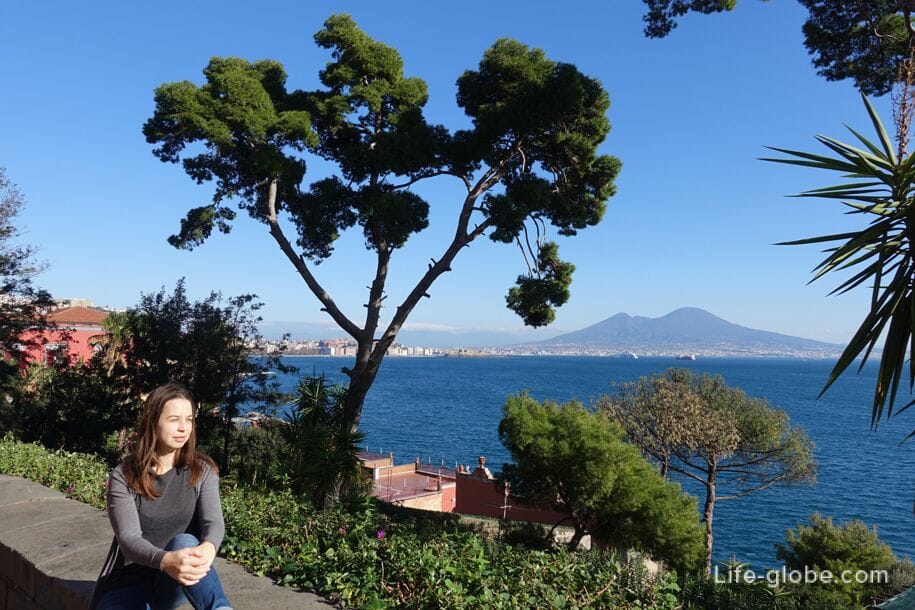
Virgiliano Park (Parco Virgiliano)
In the South-Western part of the coast of Naples, on the top of the cliff, near the island of Nisida, is the city virgiliano Park, also known as the Park of Remembrance (Parco Virgiliano).
The Park itself is a wonderful place for walks and rest, but also from observation decks offer stunning views of the Bay and the surrounding area.
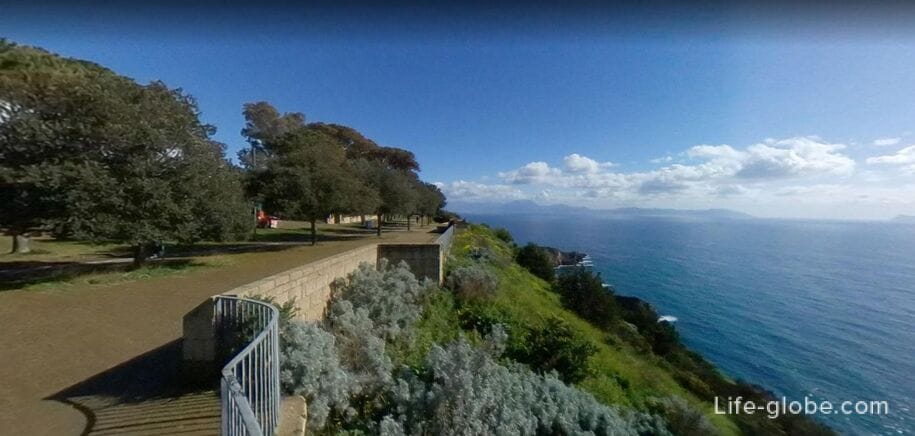
Archaeological Park Pausilypon (Parco archeologico Pausilypon)
The archaeological site includes the remnants of the amphitheatre and villas, as well as the Grotto di Seiano - artificial tunnel length of about 770 meters, crossing the tuff of the hill of Posillipo. The path of this ancient passage built about two thousand years ago by the architect Seiano.
The Park is located near the island of Nisida - Western point of the coast of the city of Naples and refers to the attractions of Naples called "Napoli Sotterranea".
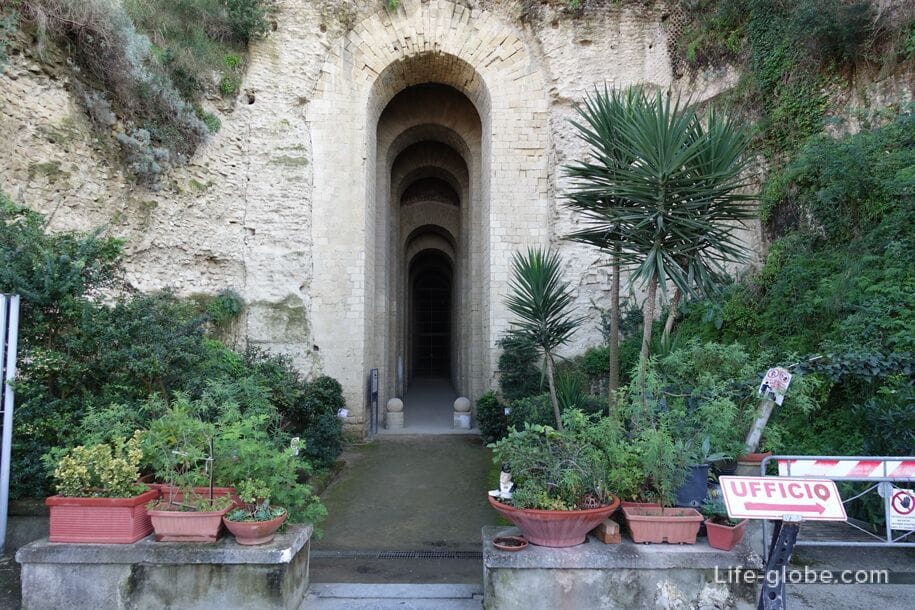
Island Nisida (Islet Of Nisida)
A small island located in the Western point of the coast of Naples, connected to the mainland by a stone bridge.
In the 16th century there was built a castle, which belongs to the family of Macedonio Fernandez. In the 19th century Nizida was a prison. During the Second world war, the island was occupied by the British army and was used as a place of detention. From 1946 through 1961 the island was Academy aircraft of the Italian air force Academy. Nisida is divided now between a naval headquarters belonging to the Italian Navy, and the place of detention of minors.
Near the island there is an observation deck.
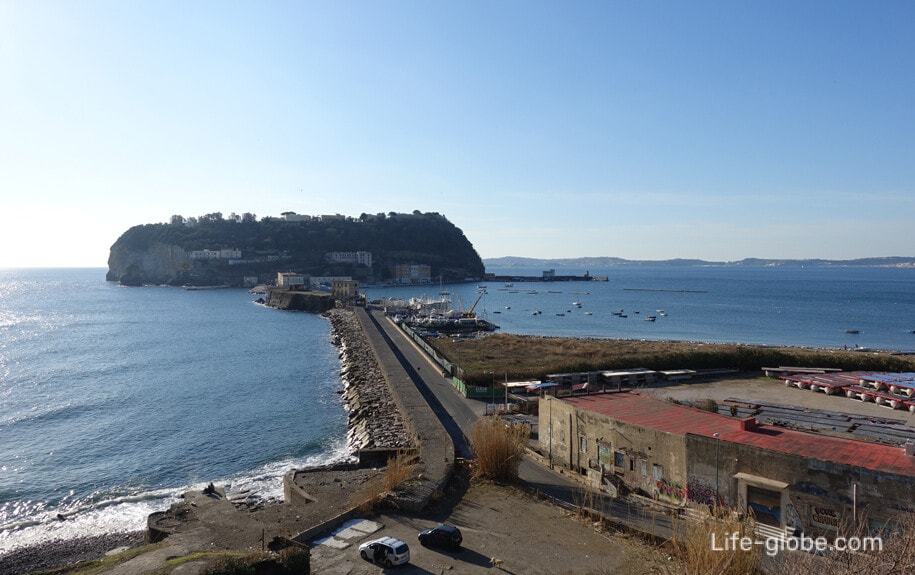

In addition to these, in Naples, many churches and chapels, squares, monuments and statues, there are also museums, villas and palaces, monuments of architecture and history.
Near Naples you can visit:
- archaeological parks Herculaneum and the Pompeii archeological site - ancient Roman city, is famous because in 79 ad, was destroyed and buried under a layer of pyroclastic flows during the eruption of Vesuvius;
- Vesuvius national Park;
- archaeological Park and Phlegraean fields (Parco Archeologico dei Campi Flegrei), which is composed of: Kuma (Sito Archeologico di Cuma), archaeological complex of the Terme di Baia (Complesso archeologico delle Terme di Baia), the Flavian amphitheatre (Anfiteatro Flavio Neroniano) and Museum;
Royal Palace of Caserta is one of the largest buildings erected in Europe in the 18th century, and the 18th largest in the world. Around the Palace you will find a most extensive English Park in Italy, among the attractions which you can select fountains and numerous sculptures.




